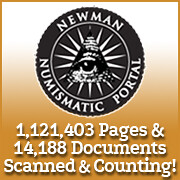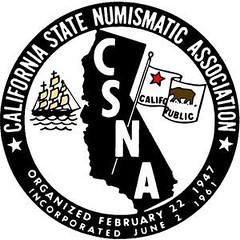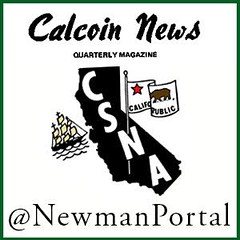
About UsThe Numismatic Bibliomania Society is a non-profit organization devoted to the study and enjoyment of numismatic literature. For more information please see our web site at coinbooks.org SubscriptionsThose wishing to become new E-Sylum subscribers (or wishing to Unsubscribe) can go to the following web page link MembershipThere is a membership application available on the web site Membership Application To join, print the application and return it with your check to the address printed on the application. Print/Digital membership is $40 to addresses in the U.S., and $60 elsewhere. A digital-only membership is available for $25. For those without web access, write to: Terry White, Treasurer AsylumFor Asylum mailing address changes and other membership questions, contact Terry at this email address: terrywhite5475@yahoo.com SubmissionsTo submit items for publication in The E-Sylum, just Reply to this message, or write to the Editor at this address: whomren@gmail.com BUY THE BOOK BEFORE THE COINSale Calendar |
- WAYNE'S WORDS: THE E-SYLUM AUGUST 20, 2017
- ASYLUM AUTUMN 2017 ISSUE PUBLISHED
- 2017 NBS PUBLICATION AWARDS
- 2017 NLG AWARDS VIDEOS PUBLISHED
- KOLBE & FANNING TO OFFER WILLIAM BURD LIBRARY
- LUPIA NUMISMATIC LIBRARY TO BE SOLD
- NUMISMATIC LITERATURE IN JACQUIER AUCTION 43
- NEW BOOK: COINS OF MACEDON PART II
- NEW BOOK: NUMISMATICS AND MONEY HISTORY
- BOOK REVIEW: BRITISH HISTORICAL MEDALS OF THE 17TH CENTURY
- 17 MOST IMPORTANT US PAPER MONEY BOOKS
- NEWMAN NUMISMATIC PORTAL ADDS THE RAG PICKER
- PROMOTING NUMISMATIC EVENTS VIA SNAPCHAT
- MORE ON SCHOOLCHILD REWARD OF MERIT MEDALS
- MORE ON IMITATION JAPANESE OBANS
- READER NOTES ON WIKIPEDIA
- NOTES FROM E-SYLUM READERS: AUGUST 20, 2017
- GARRETT ZISS' 2017 DENVER ANA DIARY
- ELLIS ISLAND QUARTER DESIGNER BARBARA FOX
- VOCABULARY TERM: VERMEIL
- HENRI DE MORGAN (1854-1909)
- QUICK QUIZ: MYSTERY YOUNG NUMISMATIST
- ARTICLE FEATURES COLONIAL FISCAL PAPER
- NICKLE GALLERIES: COINS OF JESUS EXHIBIT
- KUNSTHISTORISCHES MUSEUM: MEDALS OF MARIA THERESA
- MORE ABOUT ROYAL MINT ARTIST JODY CLARK
- CLASSICAL NUMISMATIC GROUP SALE 106
- WAYNE'S NUMISMATIC DIARY: AUGUST 20, 2017
- THE ‘NEAR SPILSBY ROMAN COIN HOARD
- DETECTORIST FINDS RARE 6TH CENTURY COIN PENDANT
- DUTCH SHIP ROOSWIJK EXCAVATED
- THE FOUNDING OF THE CENTRAL AMERICAN MINT
- MODERN BANKNOTES OF THE NETHERLANDS ANTILLES
Click here to access the complete archive
To comment or submit articles, reply to whomren@gmail.com
Content presented in The E-Sylum is not necessarily researched or independently fact-checked, and views expressed do not necessarily represent those of the Numismatic Bibliomania Society.
WAYNE'S WORDS: THE E-SYLUM AUGUST 20, 2017
 New subscribers this week include: Felix Ohmberger. Welcome aboard! We now have 3,275 subscribers.
New subscribers this week include: Felix Ohmberger. Welcome aboard! We now have 3,275 subscribers.
Thank you for reading The E-Sylum. If you enjoy it, please send me the email addresses of friends you think may enjoy it as well and I'll send them a subscription with your compliments. Contact me at whomren@gmail.com anytime regarding your subscription, or questions, comments or suggestions about our content.
This week we open with a new issue of The Asylum, NBS Publication awards, multiple numismatic literature sales, two new books and one review.
Other topics this week include The Rag Picker, Snapchat, Wikipedia, numismatic diaries from myself and Garrett Ziss, coin designers Barbara Fox and Jody Clark, the Central American Mint, colonial fiscal paper, the coins of Jesus and the medals of Maria Theresa.
To learn more about numismatic bibliomania origin stories, the William A. Burd numismatic library, contemporary catalogues of 18th century British trade tokens, U.S. paper money books, Romania's solar eclipse note, the Nixon Penny, the Pantikapaion gold stater, read on. Have a great week, everyone!
Wayne Homren
Editor, The E-Sylum
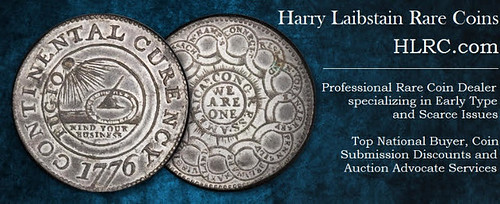
ASYLUM AUTUMN 2017 ISSUE PUBLISHED
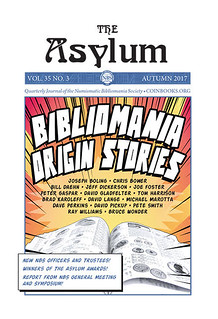 Autumn 2017 - The Asylum V35 N3
Autumn 2017 - The Asylum V35 N3
Table of Contents
Message from the President by Tom Harrison
2017-2019 NBS Board of Trustees Election Results
The Asylum’s 2016 Award Winners
NBS wins awards for publications
2017 NBS Annual Meeting and Symposium by Joel J. Orosz
Increasing Membership in the NBS: Some Preliminary Ideas by YN Kellen Hoard
Jon P. Amato, Ph.D. (1940-2017) submitted by Mark Borckardt and Mark Van Winkle
Bibliomania Origin Stories:
Joseph E. Boling, Chris Bower, Bill Daehn, Jeff Dickerson, Joe Foster, Peter Gaspar, David D. Gladfelter, Thomas D. Harrison, Brad Karoleff, David W. Lange, Michael E. Marotta, W. David Perkins,
David R. Pickup, Pete Smith, Ray Williams, Bruce Wonder
To join NBS or renew your annual membership, see:
http://www.coinbooks.org/about/membership.html
2017 NBS PUBLICATION AWARDS
THE ASYLUM AWARD WINNERS:
Jack Collins Award, Best Article by a First-Time Author in 2016:
Shanna Berk Schmidt, “The Harlan J. Berk Ltd. Numismatic Library” (v.34 n.2)
Joel J. Orosz Award, Best Article of 2016:
Christopher Faulker, “In Defense of a Library” (v.34 n.4)
NUMISMATIC LITERARY GUILD 2017 AWARDS:
Best Issue, Small-Circulation Club Publications: The Asylum, Autumn 2016, “The Future of Numismatic Literature,” Maria Fanning, editor
Best Column, Small-Circulation Club Publications: “Off the Shelf,” by David Fanning, The Asylum
PCGS Education Award: The E-Sylum, Wayne Homren, Editor, Numismatic Bibliomania Society, Publisher
To read the earlier E-Sylum article, see:
2017 NLG WRITERS’ COMPETITION RESULTS (http://www.coinbooks.org/v20/esylum_v20n32a02.html)

2017 NLG AWARDS VIDEOS PUBLISHED

NLG 2017 PGGS Education Award Winner Wayne Homren
Award Presenter, David Hall.

Wayne Homren, David Hall, Scott Travers, with Bob Van Ryzin taking photo.
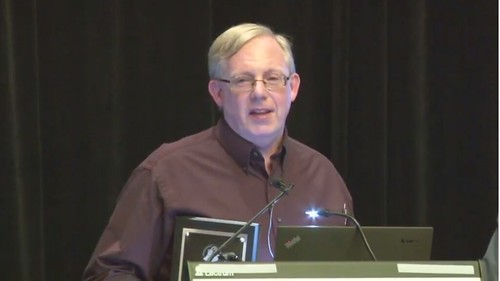
Wayne Homren accepting award
CoinTelevision: NLG 2017 PGGS Education Award Winner Wayne Homren. VIDEO: 4:07. (https://youtu.be/Z1PrTlIzvPU)
NLG 2017 Ribbit Award Winner David Hall
Michael Fuljenz, Award Presenter.
NLG 2017 Ribbit Award Winner David Hall. VIDEO: 6:00. (https://youtu.be/Z2FTlwjy0PE)
NLG 2017 Clemy Award Winner Robert Van Ryzin
Mark Borckardt, Award Presenter.

Bob Van Ryzin, Mark Borckardt, Joe Boling
NLG 2017 Clemy Award Winner Robert Van Ryzin. VIDEO: 3:31. (https://youtu.be/DAtTvZvJ1zI)
John Highfill Receives 2017 NLG Award for Silver Dollar Encyclopedia
John Highfill Receives 2017 NLG Award for Silver Dollar Encyclopedia. VIDEO: 4:29. (https://youtu.be/fQsV03fFUZY)

KOLBE & FANNING TO OFFER WILLIAM BURD LIBRARY
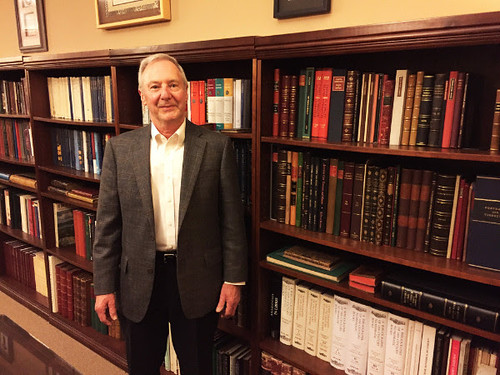
Kolbe & Fanning Numismatic Booksellers are pleased to announce that they have been chosen to offer the outstanding numismatic library formed by Chicago coin dealer William A. Burd in several upcoming auctions. The Burd Library is well known to many due to the long-standing willingness of the owner to make his library available for use by other numismatists at his Chicago Coin Company offices. With well over 10,000 items on its shelves, the library strived to be truly comprehensive, covering everything from ancient coins to modern banknotes and including material from the 16th through the 21st century.
Few libraries can be counted upon for their ability to address ancient hacksilber and modern bus tokens, United States large cents and medals of the Italian Renaissance, Chinese spade money and German notgeld. The Burd Library boasts exceptional scope as well as a depth of coverage that is truly impressive. In addition, the library includes a number of bibliophilic gems that would be the highlight of any library. A few especially noteworthy examples include:
- An exceptional, complete set of Visconti & Mongez’s glorious Iconographie Grecque et Romaine
- The extremely rare and virtually unknown first issue in book form of Louis XIV’s collection of ancient coins
- Perhaps the finest extant deluxe copy of Browning on U.S. quarter dollars
- A deluxe, large-format Bureau of Engraving and Printing vignette book featuring 223 superb engravings
- A superlative example of Ricaud de Tiregale’s masterwork on Russian medals.
The William Burd Library will be offered in several upcoming Kolbe & Fanning sales. Our Sale 147, scheduled for October 7, will include hundreds of lots from the Burd Library, while the highlights will form the foundation of our 2018 New York Book Auction, to be held in conjunction with the New York International Numismatic Convention on January 13, 2018. Additional items will be offered in other mail-bid and “buy or bid” sales in the months to come.
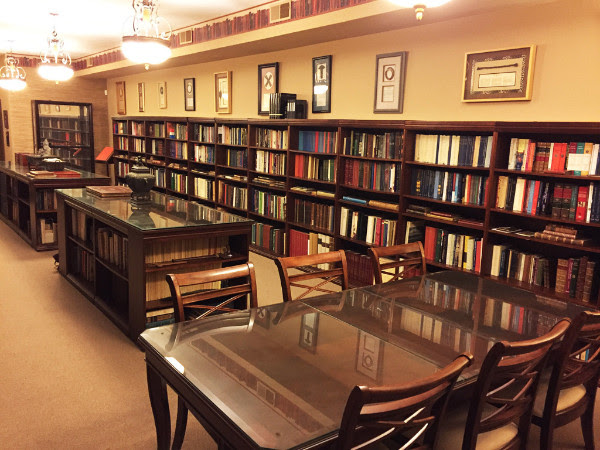
Those interested in consigning outstanding numismatic works to be included in the January 2018 New York Book Auction are invited to contact us soon. Only a small number of additional lots can be accommodated.
Kolbe & Fanning Numismatic Booksellers are a licensed auction firm specializing in the sale of rare and out-of-print numismatic literature. We also sell new and secondhand numismatic books on a retail basis through our website at numislit.com. To subscribe to our email list, please see numislit.com or contact David Fanning at df@numislit.com.
To read the earlier E-Sylum articles, see:
THE WILLIAM A. BURD NUMISMATIC LIBRARY (http://www.coinbooks.org/esylum_v13n16a04.html)
ARTICLE PROFILES BILL BURD AND HIS NUMISMATIC LIBRARY (http://www.coinbooks.org/esylum_v13n29a14.html)
VISITOR NOTES ON THE BURD NUMISMATIC LIBRARY (http://www.coinbooks.org/esylum_v14n37a09.html)
http://www.coinbooks.org/esylum_v14n35a13.html (http://www.coinbooks.org/esylum_v14n35a13.html)
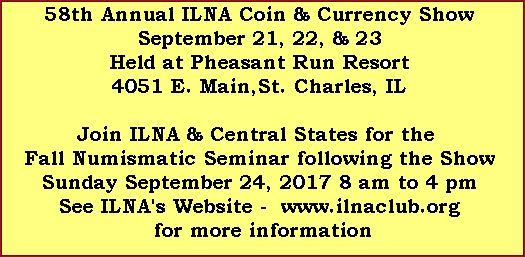
LUPIA NUMISMATIC LIBRARY TO BE SOLD
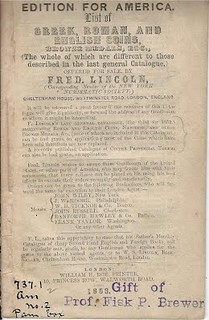 The entire inventory of the Lupia Numismatic Library is for sale. This includes coins, tokens, medals, paper money, continental currency, store cards, encased postage stamps, rare books,
private correspondence, antique maps, antique newspapers, antiquities, medieval items, and much more.
The entire inventory of the Lupia Numismatic Library is for sale. This includes coins, tokens, medals, paper money, continental currency, store cards, encased postage stamps, rare books,
private correspondence, antique maps, antique newspapers, antiquities, medieval items, and much more.
Since neither the Chapman Family Correspondence Archive as a whole nor that of Hiram Edmond Deats could find an institutional or private buyer they shall, unfortunately, be broken up into parcels
and sold from the NumismaticMall.com, at U. S. philatelic auctions, and at auction in Hong Kong.
![]()

Sadly, the numismatic historical value as a whole soon will be lost to posterity forever. Every item in the Deats and Chapman Archives will be sold to anyone bidding a fair market price. Individual items will be available before the remaining archives are broken up into parcels sold at philatelic auctions in the U. S. and Hong Kong.
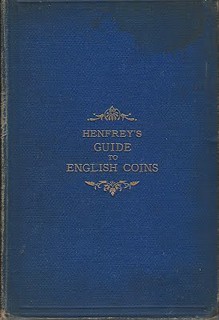
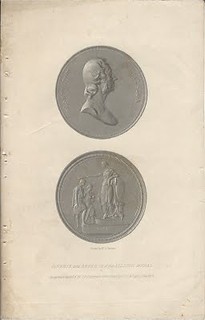
Check NumismaticMall.com frequently as dozens of new items with estimates will be posted daily beginning August 21, 2017 until everything is sold lock stock and barrel. Many treasures and surprises will be found, so keep looking.
All inquiries will be given prompt and courteous attention. Write to: john@numismaticmall.com .
To visit the web site, see:
http://www.numismaticmall.com/
NUMISMATIC LITERATURE IN JACQUIER AUCTION 43
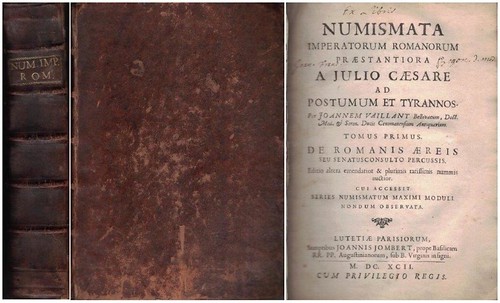
Vaillant, J. Numismata imperatorum romanorum praestantiora a Julio Caesare ad Postumum et tyrannos. 2 Vol. Paris 1692.
Paul-Francis Jacquier Auction 43 (Sept 15)
I recently received the Jacquier auction catalog and aside from the lovely coins that are being offered I want to point out that Paul-Francis also offers many duplicates from the BCD book collection.
What I appreciate as well was the care that BCD took in explaining almost every lot that is being offered from his collection.
As someone who loves the research behind coin purchases I appreciate the commentary. My first purchases from Paul-Francis in fact were books so it is very fitting that BCD would look to him for selling duplicates from his library. If you are looking to expand your library then I suggest taking a peek at this catalog which can be found on Numisbids or Sixbid.
To view the literature lots, see: https://www.sixbid.com/browse.html?auction=3952&page=6
To view the complete sale on SixBid, see:
https://www.sixbid.com/browse.html?auction=3952

NEW BOOK: COINS OF MACEDON PART II
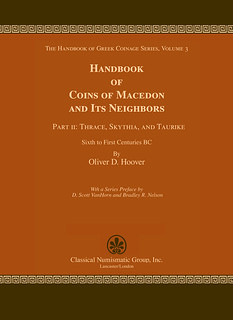 Hoover, Oliver D. Handbook of Coins of Macedon and Its Neighbors. Part II: Thrace, Skythia, and Taurike, Sixth to First Centuries BC [The Handbook of Greek Coinage Series, Volume 3].
2017. lxxii and 338 numbered pp. and two maps. Hardbound. (GR358)
Hoover, Oliver D. Handbook of Coins of Macedon and Its Neighbors. Part II: Thrace, Skythia, and Taurike, Sixth to First Centuries BC [The Handbook of Greek Coinage Series, Volume 3].
2017. lxxii and 338 numbered pp. and two maps. Hardbound. (GR358)
More than three decades have passed since David Sear published Greek Coins & Their Values, his revision of Gilbert Askew’s A Catalogue of Greek Coins published by B. A. Seaby in 1951. Since then, the field of ancient numismatics and the hobby of collecting ancient coins have changed so much that now Greek Coins & Their Values would require a complete revision to include all of the most current numismatic information available, list the many new types and varieties unknown to Sear, and determine an approximate sense of rarity for all of these issues.
In order to encompass this new material and create a viable reference for the beginning and specialized collector, such a handbook would have to be more than the two volumes which Sear found necessary. As a result, Classical Numismatic Group is publishing The Handbook of Greek Coinage Series, written by Oliver D. Hoover, in a series of 13 volumes, each covering a specified area of Greek coinage with the first being The Handbook of Syrian Coins: Royal and Civic Issues, Fourth to First Centuries BC (Volume 9 in the series).
This series is designed to aid the user in the quick, accurate, and relatively painless identification of Greek coins, while providing a cross-reference for each entry to a major work, which will allow the inquirer to pursue more in-depth research on the subject. The subject-matter of each volume is arranged chronologically for royal issues, and regionally for the civic issues; within each region, cities are listed directionally, depending on the region. For those rulers or cities that issued coins concurrently in all three metals, these issues will be arranged in the catalog with gold first, followed by silver, and then bronze; each metal is arranged by denomination, largest to smallest. Known mints for the royal coinage are listed below the appropriate type, making an easy search for a specific mint.
Each entry will include a rarity rating based on the frequency with which they appear in publications, public and private collections, the market, and/or are estimated to exist in public or private hands. No valuations are listed, since such values are generally out of date by the time of publication. An online valuation guide at www.greekcoinvalues.com will allow interested individuals the opportunity to gauge the market, and reduce the need for repeated updates of this series.
Whether one purchases the entire set for their reference library, or the individual volume pertaining to one’s area of specialization, The Handbook of Greek Coinage Series should provide a useful staging-point from which collectors and interested scholars can pursue their research and interests.
The tenth published volume in the series is Handbook of Coins of Macedon and Its Neighbors. Part II: Thrace, Skythia, and Taurike, Sixth to First Centuries BC (the second part of Volume 3 in the series). This volume, picking up where Part I leaves off, is arranged first with the cities, beginning with Thrace, followed by Skythia and Taurike. These issues are then followed by dynastic and royal coinage, beginning with Thrace, followed by Skythia and Taurike. Civic coinage is arranged chronologically, beginning with the Archaic issues and continuing through the later civic issues. Where rulers or cities issued coins concurrently in all three metals, these issues will be arranged in the catalog with gold first, followed by silver, and then bronze; each metal is arranged by denomination, largest to smallest.
Formore information, or to order, see:
Volume 3, Part II Handbook of Coins of Macedon and Its Neighbors, Part II (https://www.cngcoins.com/Coin.aspx?CoinID=339209)
NEW BOOK: NUMISMATICS AND MONEY HISTORY
 The Austrian numismatic society in 2015 published in a splendid double volume of their proceedings of a Dresden symposium on 18th century numismatic literature, with these contributions in
English:
The Austrian numismatic society in 2015 published in a splendid double volume of their proceedings of a Dresden symposium on 18th century numismatic literature, with these contributions in
English:
Andrew Burnett, ‘The development of numismatics in Britain during the 18th century’, pp.29-41;
François de Callataÿ, ‘Vaillant, Frölich and the others...: the remarkable interest in Seleucid coinages in the 18th century’, pp.43-77;
Marco Callegari, ‘Self-promotion and erudition: numismatic publication in the Serenissima Repubblica di Venezia during the 18th century’, pp.79-84;
David W. Dykes, ‘The eighteenth-century British trade token: the contemporary catalogues’, pp.157-92;
Giovanni Gorini, ‘The study of Greek numismatics during the 18th century in Italy’, pp.233-44;
Jørgen Steen Jensen, ‘The development of the Copenhagen cabinet in the middle of the 18th century...’, pp.343-9;
Janjaap Luijt, ‘Nicolas Chevalier (1661-1720), coin dealer and numismatist’, pp.351-63;
Hugh Pagan, ‘The role of the Society of Antiquaries of London in the advancement of numismatic research during the eighteenth century’, pp.365-93;
Robert H. Thompson, ‘Thomas Snelling, senior (1712-1773), and other scholarly coin dealers’, pp.479-99.
There are contributions also in French, German, and Italian to: Numismatik und Geldgeschichte im Zeitalter der Aufklärung: Beiträge zum Symposium im Residenzschloss Dresden, 4.-9. Mai 2009 = Numismatische Zeitschrift 120./121. Band, herausgegeben von Heinz Winter und Bernhard Woytek (Wien, 2015).
For more information, see:
https://www.oeaw.ac.at/antike/publikationen/neuerscheinungen/

BOOK REVIEW: BRITISH HISTORICAL MEDALS OF THE 17TH CENTURY
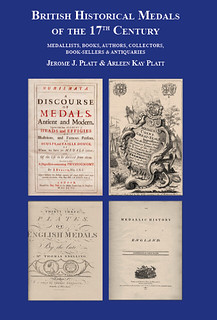 Reviews: PLATT, Jerome J. & PLATT, Arleen Kay. British historical medals of the 17th century: medallists, books, authors, collectors, book-sellers & antiquaries. London:
Spink, 2017. xvi, 416 pp.: illus. isbn 9781907427480. £50.00.
Reviews: PLATT, Jerome J. & PLATT, Arleen Kay. British historical medals of the 17th century: medallists, books, authors, collectors, book-sellers & antiquaries. London:
Spink, 2017. xvi, 416 pp.: illus. isbn 9781907427480. £50.00.
This companion to the authors’ The English Civil Wars (2013) publishes material they could not include in those two volumes. The contents are: ‘Authors and published works associated with British medals of the 17 th century’, in chronological order apart from H. W. Henfrey (p.80); ‘Medallists associated with 17 th-century British medals’, and ‘Later medallists’; ‘Some eminent collectors and collections of 17 th c. British medals’, including the royal collections; and ‘Antiquaries, chroniclers, engravers, printers, book- & print-sellers’. The entry for Richard Southgate (p.280) helpfully names the author of the life prefixed to his sale catalogue as Charles Combe (see p.85), which I overlooked for my Southgate entry in the Oxford DNB.
This splendid volume will be mainly of use for illustrations of individuals and their title-pages. As regards the text, there are rather too many errors in names, e.g. ‘Sir’ Martin Folkes, which he never was (p. xi, but correct on p. 349), and the uncouth ‘Gouth’ for the eminent antiquary Richard GOUGH, nine times on p.397, yet the heading is correct. It is difficult to understand how this came about.
However, Dr and Mrs Platt have searched widely for illustrations of medals, portraits, and title-pages, and have ensured good reproductions in colour. The result is a very handsome bio-bibliography.
To read the earlier E-Sylum article, see:
NEW BOOK: BRITISH HISTORICAL MEDALS OF THE 17TH CENTURY (http://www.coinbooks.org/v20/esylum_v20n32a03.html)
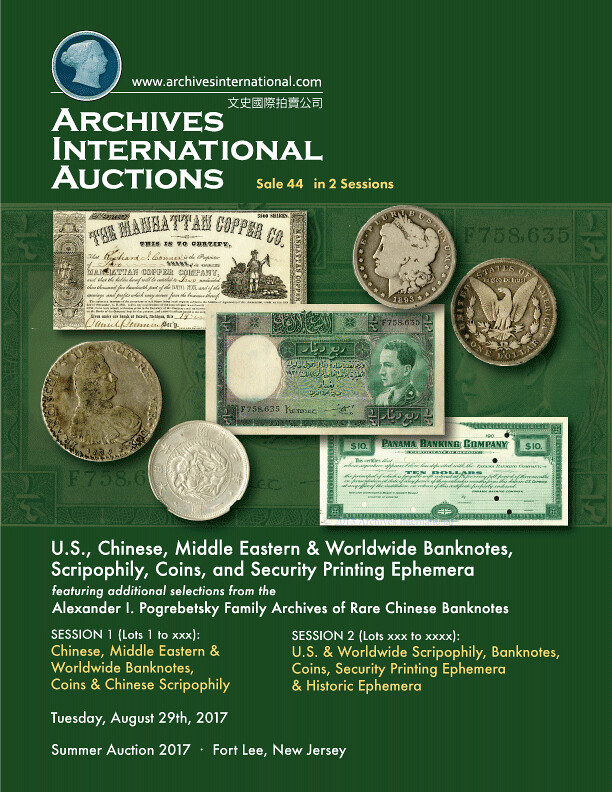
17 MOST IMPORTANT US PAPER MONEY BOOKS
PMG uses many of the books from this list for note identification and authentication purposes.
“Buy the book before you buy the note.” There is a high likelihood that you’ve heard that expression before. The reason behind it is an easy one – the more knowledge you have, the better chance you will make a good purchase. Knowledge is key. The more time you spend with a particular type of note, the more knowledge you will want to seek out. Below is a list of 17 books that should be in every collector's library. These books will help expand your knowledge of paper money and (hopefully) prevent you from purchasing a bad note. Many times, the price of one book is far cheaper then the majority of notes on the market.
This list demonstrates a fairly comprehensive US paper money library. It covers the basic to the more specific. There are plenty of other books that didn’t make the list that PMG has reviewed (Heath's Counterfeit Detector or Ball's Confederate Bond Book) or that folks have talked about in our forums. Are you interested in a more niche area? Find others who collect the same things as you do and compete for the best set over at the PMG Registry, or talk to other collectors about the more technical aspects of a given area via the PMG Chat Boards. There are always more books that come to the market every month (or so it seems). If you are interested in joining a group who likes to talk books then the Numismatic Bibliomania Society may be for you.
Below is a quick list of the titles that should be in your numismatic library in alphabetical order by author’s surname. The most recent edition’s ISBN number has been included.
|
|
|
|
|
| Collector’s Guide to Modern Federal Reserve Notes | Robert Azpiazu | Whitman Publishing | 0794832377 |
| United States Paper Money Errors | Dr. Frederick J. Bart | Coin & Currency Institute | 978-0-87184-250-3 |
| Comprehensive Catalog of Confederate Paper Money | Grover C. Criswell | BNR Press | 978-0-93196-047-5 |
| Collecting Confederate Paper Money | Pierre Fricke | Pierre Fricke | 978-0-9844534-9-8 |
| Paper Money of the United States | Arthur L. and Ira S. Friedberg | Coin & Currency Institute | 978-0-87184-520-7 |
| Standard Catalog of United States Obsolete Bank Notes 1782-1866 Vol 1 to 4 | James A. Haxby | Krause Publications | 0-87241-043-2 |
| Counterfeiting and Technology | Bob McCabe | Whitman Publishing | 978-079484-395-3 |
| The Early Paper Money of America | Eric P. Newman | Krause Publications | 978-089689-326-9 |
| Comprehensive Catalog of Military Payment Certificates | Fred Schwan | BNR Press | 0-931960-61-4 |
| Standard Guide to Small-Size US Paper Money | John Schwartz and Scott Lindquist | Krause Publications | 978-1-4402-1703-6 |
| Southern States Currency | Hugh Shull | Whitman Publishing | 0794820573 |
| US Error Note Encyclopedia | Stephen M. Sullivan | US Currency Gallery | 978-0-578-04520-7 |
| 100 Greatest American Currency Notes | David M. Sundman and Q. David Bowers | Whitman Publishing | 978-0-79482-006-0 |
| Counterfeit Confederate Currency | George B. Tremmel | Whitman Publishing | 0794822908 |
Paper Money of the United States
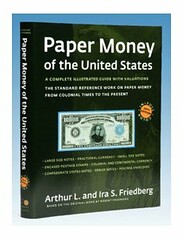 If you were to buy one book from this list, this is the book. It has been in full color since the 19th edition and covers over 260 years of American paper money – from Colonial notes to
Federal Reserve Notes (FRNs), to Confederates. The book even covers encased postage stamps and postage envelopes. The official abbreviation for this book is Fr. It is the holy grail in terms of US
government issued money. The Friedberg brings so much to the hobby. It has great historical insight as well as a complete catalog of all US issued paper money with evaluations. The 20th edition comes
in hardback and e-book.
If you were to buy one book from this list, this is the book. It has been in full color since the 19th edition and covers over 260 years of American paper money – from Colonial notes to
Federal Reserve Notes (FRNs), to Confederates. The book even covers encased postage stamps and postage envelopes. The official abbreviation for this book is Fr. It is the holy grail in terms of US
government issued money. The Friedberg brings so much to the hobby. It has great historical insight as well as a complete catalog of all US issued paper money with evaluations. The 20th edition comes
in hardback and e-book.
Standard Guide to Small-Size US Paper Money
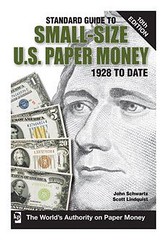 The go-to for the US small size collector. In its 10th edition, this book has been around for a long time. Over the course of the life of this book, over 260 people have contributed to make
it the most sought after and recognizable book for the small size enthusiast. The book has information starting with series 1928 going through series 2006A, along with indispensable knowledge on
light versus dark seals and mules. There is even information regarding high denominations: $500 to $10,000. See all the scans in full color throughout this book
The go-to for the US small size collector. In its 10th edition, this book has been around for a long time. Over the course of the life of this book, over 260 people have contributed to make
it the most sought after and recognizable book for the small size enthusiast. The book has information starting with series 1928 going through series 2006A, along with indispensable knowledge on
light versus dark seals and mules. There is even information regarding high denominations: $500 to $10,000. See all the scans in full color throughout this book
United States Paper Money Errors
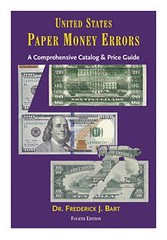 Bart does a great job by combining how the error was printed and what the error looks like with black and white scans. It’s easy to find and identify what error you are looking for. PMG
uses the terms in this book when describing an error on our labels. This book by Bart and the companion book that follows (by Sullivan) are the best in the business. They each cover something a
little different. Each adds to the existing literature on the subject of US errors.
Bart does a great job by combining how the error was printed and what the error looks like with black and white scans. It’s easy to find and identify what error you are looking for. PMG
uses the terms in this book when describing an error on our labels. This book by Bart and the companion book that follows (by Sullivan) are the best in the business. They each cover something a
little different. Each adds to the existing literature on the subject of US errors.
To read the complete article, see:
The 17 Most Important US Paper Money Books That Should Be In Your
Library (https://www.pmgnotes.com/news/article/6070/The-17-Most-Important-US-Paper-Money-Books-That-Should-Be-In-Your-Library/)
THE BOOK BAZARRE
NEWMAN NUMISMATIC PORTAL ADDS THE RAG PICKER
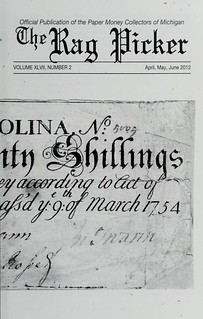 The Rag Picker, published by the Paper Money Collectors of Michigan (PMCM) is now available on the Newman Portal for the years 1966 – 2012. The PMCM, although launched in Michigan,
is today a national organization of paper money collectors. Recent issues of the Rag Picker emphasize obsolete and federal reserve banknotes, and the journal also serves as a forum for members
to buy, sell, and trade amongst one another. The Newman Portal is grateful to Peter Huntoon and Bill Brandimore for loaning back issues, and to PMCM for sharing their back issues with the wider
numismatic community.
The Rag Picker, published by the Paper Money Collectors of Michigan (PMCM) is now available on the Newman Portal for the years 1966 – 2012. The PMCM, although launched in Michigan,
is today a national organization of paper money collectors. Recent issues of the Rag Picker emphasize obsolete and federal reserve banknotes, and the journal also serves as a forum for members
to buy, sell, and trade amongst one another. The Newman Portal is grateful to Peter Huntoon and Bill Brandimore for loaning back issues, and to PMCM for sharing their back issues with the wider
numismatic community.
Link to The Rag Picker:
https://nnp.wustl.edu/library/publisherdetail/521679
PROMOTING NUMISMATIC EVENTS VIA SNAPCHAT
As one of the YNs who attended the EAC General Meeting in Denver, I found the CoinWeek article about that very event interesting. In the piece, Morgan and Walker express doubt about the capabilities of Snapchat in terms of sharing the hobby. They bring up some valid points, and I do agree that Snapchat is not the most effective social media to use.
However, it does have one specific feature which I believe could be utilized. This is the “Our Stories” component. Users of the app can post a picture a picture or video to “Our Story” via a button. If enough people post (using this feature) in a certain location, Snapchat and its users can see something notable is happening there. This means that if several people post while at the ANA Convention, it could attract the attention of people using the app. Additionally, if a lot of people post, it could become what is called a “trending topic.” This means that the event is visible on the front page of Snapchat. Thus, events like this get free promotion. I will mention yet again that I do not believe Snapchat is the best choice for numismatic promotion, but it does have this one option.
Second, I would like to address another point in the article: “the one thing absent from this discussion…was how we can better communicate to collectors already in the hobby that don't feel like they are part of our community…” One idea that comes to mind is more discussion between major organizations and the people following them. Many numismatic groups have social media accounts with thousands of followers, but do not try to be social! I have seen many instances where the organization posts something, some followers respond, but then no further discussion is had. If there was an active conversation going on, I believe it could help to make some collectors feel like they are part of the community.
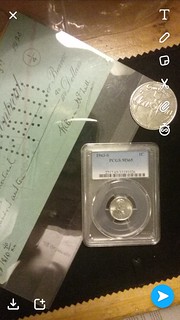
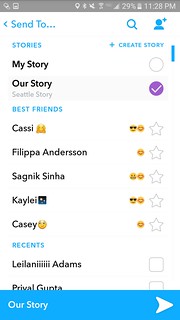

LEFT: Here you can see that I have take a picture of some numismatic items. I have a variety of options for what I can do with this picture, but to post it I will click the blue arrow on the bottom right.
CENTER: Once I click the blue arrow, I come to this page. As you can see, many of the people I talk to on the app are visible on this page. The most important thing, however, is the "Our Story" button/bar second to the top. As you can see, I have clicked it and can now post it via the white arrow at the bottom right.
RIGHT: This picture shows what happens once enough people post pictures or videos from some location.The red spot on the map shows the concentration of posts, and if I were to click on the spot I could see all the posts from there. You can also see that CenturyLink Field and Pike Place Market have individual tags. This is because so many people are posting from there that they are on the front page of Snapchat.
To read the earlier E-Sylum article, see:
BRIDGES TO NEWER GENERATIONS OF COLLECTORS (http://www.coinbooks.org/v20/esylum_v20n33a24.html)

MORE ON SCHOOLCHILD REWARD OF MERIT MEDALS
Tom Casper of Muskego, Wisconsin writes:
I was glad to learn of the book, Rewards of Merit, mentioned in The E-Sylum last week. I first learned about these Reward of Merit items from the book, College Currency, 1993, by Herb and Martha Schingoethe, pages 28-30.
Since that time I have formed a small collection of both the certificates and medals. The medals are much less common than the certificates. I have only three medals in my collection. Here are scans and descriptions of the three.
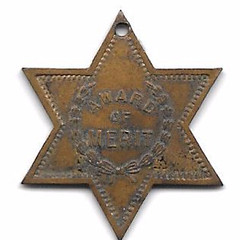
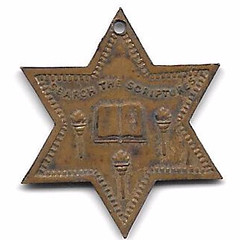
Search the Scripture//Award of Merit Star-shaped, copper, 23mm x 26mm

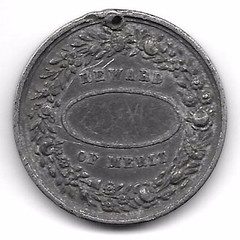
Remember Thy Creator In The Days Of Thy Youth, (in small letters at bottom) J. S. Smith F.//Reward of Merit Round, white metal, 34mm
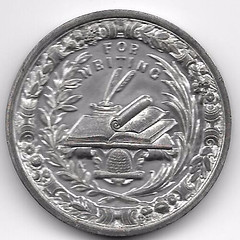

For Writing, (on scroll) Allen & Moore, BIRMm//Reward of Merit, (at bottom) Allman, London Round, white metal, 44mm
To read the complete article, see:
BOOK: SCHOOLCHILD CERTIFICATES AND MEDALS (http://www.coinbooks.org/v20/esylum_v20n33a06.html)
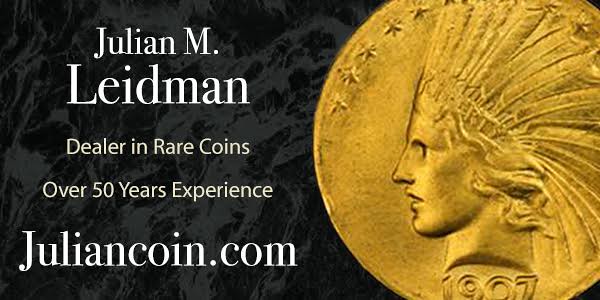
MORE ON IMITATION JAPANESE OBANS

Dick Hanscom writes:
I was sure they were not original obans, but thought they might have been later (1900s) bullion pieces. I am sorry that I could not send better scans. I was sure that someone would recognize the markings on the back, by shape if not by faint inscription. Here are enlargements. The gold is still faint, but the silver is not bad. Both state ".999."
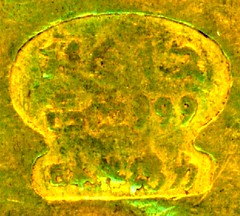

The gold weighs 3.67 grams

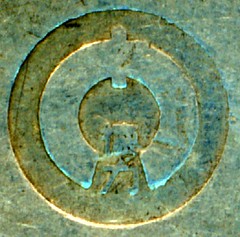
The silver weighs 3.81 grams
Kyle Ponterio writes:
It would appear that these two pieces are much later than I had originally thought. To my knowledge none of the early fantasy issues have any markings on them stating their purity. I’m not sure exactly what these are - perhaps these pieces are more along the lines of what Bruce said in that they are advertising pieces, but being 999 fine does not make sense to me as that would have been quite a bit of money just for advertising. Maybe these are museum copies of some sort sold to tourists. At any rate, these are not genuine contemporary pieces and would be grouped together with the fantasy issues.
To read the complete article, see:
NOTES FROM E-SYLUM READERS: AUGUST 13, 2017 : Imitiation Japanese Oban (http://www.coinbooks.org/v20/esylum_v20n33a14.html)
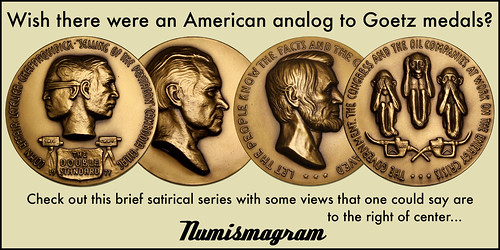
READER NOTES ON WIKIPEDIA
Wikipedia as a Research Tool
Len Augsburger of the Newman Numismatic Portal writes:
Wikipedia is recognized within academia as a useful research tool. At Washington University in St. Louis, the library offers courses on Wikipedia editing and creation. While substantive research must always be grounded in primary material, Wikipedia is an important aggregator of citations to little-known sources. Scholars ignore these at their own peril.
Within the Newman Numismatic Portal (NNP), Washington University student Syrus Jin has created a number of numismatic articles on Wiki that cite primary material available on NNP. Recently he wrote a summary of the Coinage Act of 1853, which, for example, references a Senate report from 1852 (loaned by Dan Hamelberg some time ago and scanned by NNP).
Link to Wiki article on the 1853 Coinage Act:
https://en.wikipedia.org/wiki/Coinage_Act_of_1853
Link to 1852 Senate report on circulating coinage:
https://nnp.wustl.edu/library/book/517155
ANS Coin Database Images under a Creative Commons License
David Hill is the Francis D. Campbell Librarian of the American Numismatic Society. He writes:
I’ve been following the discussion in E-Sylum about Wikipedia as an information source. Wikipedia administrator Gary Greenbaum noted that:
"We can’t use images from other sites unless they’ve been released under a Creative Commons or similar license.”
I wanted to point out that the ANS coin database MANTIS currently has about 150,000 images available for use under a Creative Commons license, and that number is growing every day.
Many thanks to ANS for making these images available, and to David Hill for reminding us. -Editor
Gary Greenbaum writes:
That’s definitely going to be a big plus. I’ll start a gradual replacement of the poorer quality images and see if I can recruit some help.
To search the ANS MANTIS database, see:
http://numismatics.org/search/
To search for "united states commemorative", see:
http://numismatics.org/search/results?q=fulltext%3Aunited+states+commemorative+AND+imagesavailable%3Atrue
To read the earlier E-Sylum article, see:
THE MAKING OF A WIKIPEDIA ARTICLE (http://www.coinbooks.org/v20/esylum_v20n33a13.html)
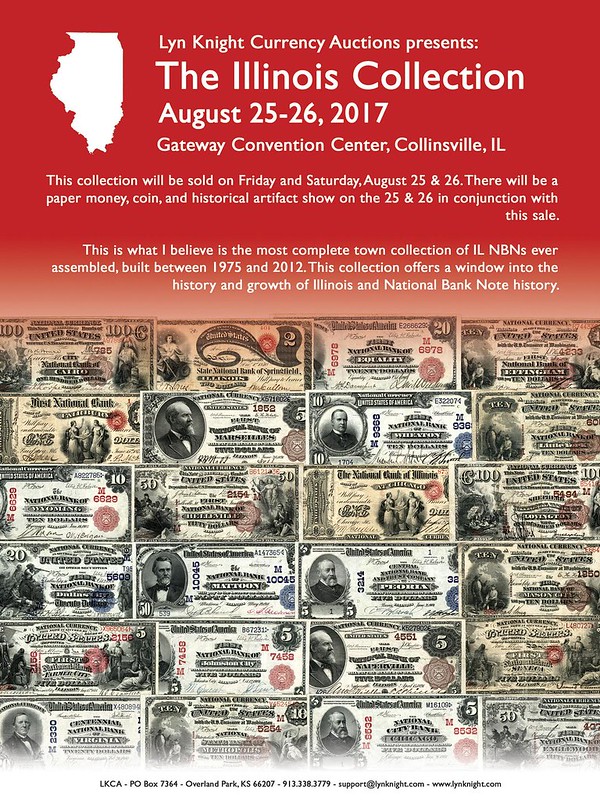
NOTES FROM E-SYLUM READERS: AUGUST 20, 2017
Romania Solar Eclipse Note
Mike Marotta of Michigan writes:
Attached are images of the 2000-lei note from Romania marking the last full solar eclipse of the 20th century. The path of totality passed over that country. (I bought two of these. One is still in its original package, of course.)
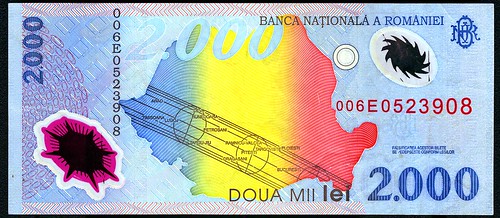
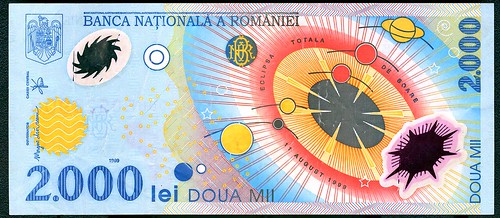
For more information on the solar eclipse of August 11, 1999, see:
Solar eclipse of August 11, 1999 (https://en.wikipedia.org/wiki/Solar_eclipse_of_August_11,_1999)
To read the earlier E-Sylum article, see:
A NUMISMATIC CELEBRATION OF THE TOTAL ECLIPSE (http://www.coinbooks.org/v20/esylum_v20n33a10.html)
The "Nixon Penny"
David Pickup of Oxford Numismatic Society writes:
Here are photos of a coin I bought last week for £2.50. Do you who issued them and why?


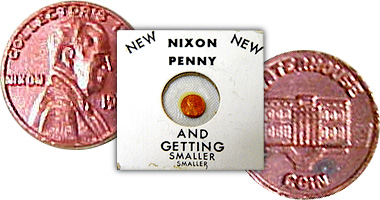
Token: US Nixon Penny 1974
These tiny pennies, about one-quarter the size of a regular US cent, were packaged in cardboard holders and issued as political commentary and novelty items about President Richard Nixon.
Most of these show the effects of time. The cardboard is discolored and marred. Such beat-up specimens are worth about $1 US dollar
To read the complete article, see:
Token: US Nixon Penny 1974 (http://coinquest.com/cgi-bin/cq/coins?main_coin=14728)
More on Russian Medal Books
Regarding the Russian naval medals book, Ron Haller-Williams writes:
They are said by one seller to be volume 1 of a 2-volume set (Vol.2 covering 1917-1945). However, that's actually volume 2 part 1, with part 2 covering 1945-2004, see https://www.ozon.ru/context/detail/id/1522015/ 589 rubles; the other volumes are 345 and 216 rubles, so set of three for 1150 rubles = $19.24 plus freight plus currency exchange loading) (I'd suggest you have your browser translate this page, and you also scroll down to "We also recommend")
Dunno if they accept orders from outside the Russian Federation and former USSR, though. Might also like to look at "Orders, awards and medals from Peter I to the present" at
https://www.ozon.ru/context/detail/id/27964315/ (559 rubles)
https://www.ozon.ru/context/detail/id/28704420/ (165 roubles ebook)
To read the earlier E-Sylum article, see:
NOTES FROM E-SYLUM READERS: AUGUST 13, 2017 : Notes From Bruce W. Smith (http://www.coinbooks.org/v20/esylum_v20n33a14.html)
Query: Mystery Persian Coin
David Pickup writes:
Can any of your readers identify the attached photo of a Persian coin or medallion please? It is about crown size.
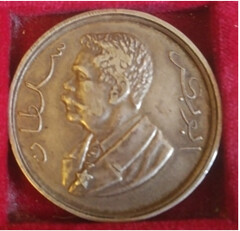
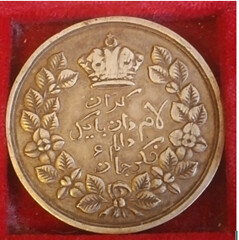
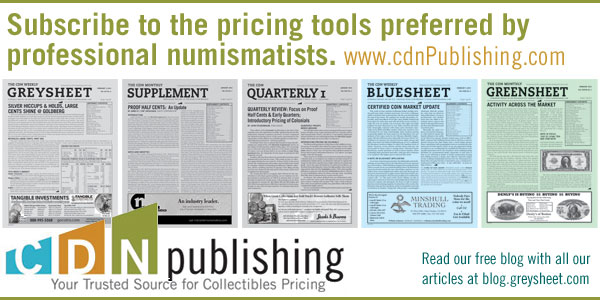
GARRETT ZISS' 2017 DENVER ANA DIARY
I was thrilled to be able to attend the World’s Fair of Money (WFOM) last week in Denver. One highlight of the convention was seeing so many JRCS members that I have not seen since the 2015 WFOM in Chicago, as well as meeting several JRCS members for the first time. No offense to any of you, but the JRCS member I was the most excited to meet is the gentleman pictured below, Mr. John McCloskey. It was an honor to meet a founding member of our club (and the LSCC) and one of the authors of the Early U.S half dime and dime books.
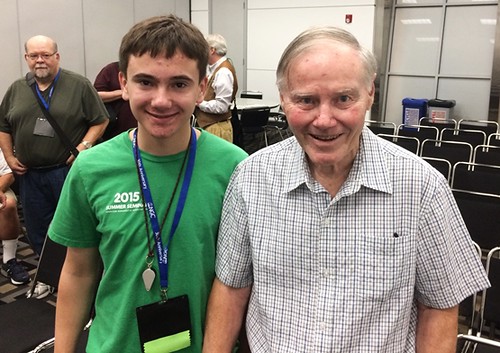
Garrett Ziss and John McCloskey
Other convention highlights for me, in no special order, were: spending time with Dr. Peterson to view images and discuss the die states of the 1820 O-106 Capped Bust half dollar, participating in the 1830 die state study at the BHNC meeting, as well as hearing Dr. Link’s excellent presentation earlier in the meeting. He reminded us that our collections represent special personal connections and are not just inanimate objects. Another talk I enjoyed at the WFOM, was hearing Wayne Homren discuss the process of how he manages to put together a beefy issue of the E-Sylum every single week (I’ve wondered about that for a while).
Of course, I was also happy to pick up a few items at the convention. I hadn’t bought a Bust half in 8 months, so I was excited to end this drought in Denver by purchasing 4 nice Capped Bust half dollars. At the NBS auction, I also added to my numismatic literature collection, and obtained a Chapman catalog from the 1895 Richard Winsor auction and a Green reprint of Early Coins of America, by Crosby.
The last item I purchased before leaving Denver on Friday, was a collection of B. Max Mehl promotional items in their original envelope. After doing a bit of research, I concluded that the envelope was mailed in 1926. I also discovered that one of the items in the envelope, the Star Coin Book (second edition), was probably not sent to the customer at that time. The book is not dated, but according to info I found on the Newman Numismatic Portal, the book was likely published in 1908. None of the items from Mr. Mehl’s envelope are in pristine condition, but it is definitely interesting to see how coin dealers marketed their numismatic items before the existence of the internet. In fact, in a previous Penny-Wise article, it mentioned that at one time, half of the mail entering Fort Worth, TX was for B. Max Mehl!
To read the complete issue, see:
JR Newsletter: 13 August 2017 (356)
(http://mailchi.mp/c6b510272772/jr-newsletter-13-august-2017-356?e=9b1d009ea9)

For more information on the John Reich Collectors Society, see:
https://www.jrcs.org/
To visit the Newman Numismatic Portal, see:
https://nnp.wustl.edu/

ELLIS ISLAND QUARTER DESIGNER BARBARA FOX
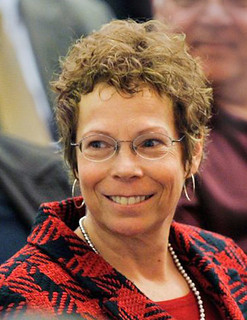 Local artist Barbara Fox will be recognized Aug. 30 on Ellis Island by the United States Mint for her most recent design featured on the 2017 Ellis Island National Park quarter.
Local artist Barbara Fox will be recognized Aug. 30 on Ellis Island by the United States Mint for her most recent design featured on the 2017 Ellis Island National Park quarter.
Fox, a master designer for the U.S. Mint, has been part of its “artistic infusion program” since 2007. Sculpted by U.S. Mint sculptor-engraver Phebe Hemphill, Fox’s design featured on the reverse side of the Ellis Island quarter depicts an immigrant family approaching Ellis Island with a mixture of hope and uncertainty.
This is Fox’s 21st coin or medal designed for the Mint, as well as her fifth quarter design chosen to be minted. She has designed four other quarters for the America the Beautiful Quarters Program including Cumberland Gap National Historical Park in 2016, Saratoga National Historical Park Quarter in 2015, Acadia National Park in 2012 and Glacier National Park in 2011.
Local artist Barbara Fox will be recognized Aug. 30 on Ellis Island by the United States Mint for her most recent design featured on the 2017 Ellis Island National Park quarter.
Fox, a master designer for the U.S. Mint, has been part of its “artistic infusion program” since 2007. Sculpted by U.S. Mint sculptor-engraver Phebe Hemphill, Fox’s design featured on the reverse side of the Ellis Island quarter depicts an immigrant family approaching Ellis Island with a mixture of hope and uncertainty.
This is Fox’s 21st coin or medal designed for the Mint, as well as her fifth quarter design chosen to be minted. She has designed four other quarters for the America the Beautiful Quarters Program including Cumberland Gap National Historical Park in 2016, Saratoga National Historical Park Quarter in 2015, Acadia National Park in 2012 and Glacier National Park in 2011.
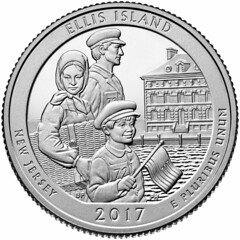 “When I began researching, I didn’t know that half of Ellis Island belongs to New Jersey and half to New York,” she said. “This is New Jersey’s quarter and, unfortunately, the big main
administration building that all the immigrants went through is located on the New York side, so I featured the hospital building that is on the New Jersey side.”
“When I began researching, I didn’t know that half of Ellis Island belongs to New Jersey and half to New York,” she said. “This is New Jersey’s quarter and, unfortunately, the big main
administration building that all the immigrants went through is located on the New York side, so I featured the hospital building that is on the New Jersey side.”
In her design, Fox wanted to not just show the building, but she also wanted to show her emotional feeling about it, which was transferred to her drawing. Although her drawing is busy with details, she thinks people liked it because it really tells the story about the island and the experience of being an immigrant.
“These people were leaving everything they knew behind and chances were they would never go back to their country. They were making a whole new life in a place they had never been before,” she said. “They didn’t speak the language and didn’t know the customs. Chances are they knew nothing about the U.S. except what they had been told. They used to call Ellis Island the ‘Island of Hope’ and ‘Island of Tears’ because people were very hopeful about coming to the United States.”
To read the complete article, see:
Local artist designs New Jersey quarter
(http://www.salamancapress.com/news/local-artist-designs-new-jersey-quarter/article_b5806a68-81e1-11e7-b7ac-9f37e26515ff.html)
VOCABULARY TERM: VERMEIL
Vermeil. Goldplated silver or silver gilt. Such a composition has the texture, fineness, hardness and smooth finish of silver, but the color of gold. Vermeil (pronounced vair-MAY) was originally an early goldplating process, FIREGILDING, developed in France in mid 1700s. The process burned off mercury vapors that were injurious to the workers, forcing the abandonment of the process in early 19th century. Firegilding could be applied to bronze and other base metals as well as silver and the early use of the term does not always mean the base metal is silver.
With the development of electroplating in the 1840s gold was electrodeposited on silver and base metals completely eliminating the deadly process of firegilding. While the term is French, it was first used for goldplating silver in England in 1858.
Vermeil must be hallmarked by law because of its precious metal content (in England since 1904, in America since 1906). The hallmarking can take any form as long as the silver is identified: argent, plata, fine silver, coin silver, .999 silver (the gold may be omitted, or stated: pure goldplate, 24K gold plate, H.G.P., or – more recently– layered in pure gold.
Vermeil was early used for silver objects as household silver and decorative objects for the obvious reason -- it had a higher value than silver but less than gold. It was not immediately adopted for medals or medallic art after its introduction in the 1850s but was adopted for award medals early in the 20th century again for a rank between gold and silver. Vermeil was adopted for a variety of compositions for collectors, Later, the popularity of Presidential Inaugural Medals, vermeil medals were struck for the Gerald R. Ford Medal in 1974 and later Inaugural Medals.
Vermeil was revived somewhat in the jewelry field by Tiffany & Co. in the mid 1950s. They had developed a process of using multiple plating tanks which reduced the gold content, but retained the color and hardness. Such objects may be found marked 22 1/2K or even 18 1/2K goldplated. (Only pure metals can be used in ELECTROPLATING, which see.)
Private mints in modern times eagerly adopted the term vermeil for use in their sales promotion literature because it sounded elite and exclusive. Such mints could produce a product in silver that looked like gold, tout it for its precious metal content, and let their advertising copywriters revel in the use of the term vermeil.
The word vermeil differs from all other gold metal and imitation gold terms as GOLD LEAF, GOLD FILLED GOLDWASH, GOLD TINT, IMMERSION GOLD MOSAIC GOLD and ROLLED GOLD,
CLASS 09.7

HENRI DE MORGAN (1854-1909)
Henri de Morgan was an archaeologist, numismatist and coin dealer who also catalogued for several auctions in New York City where he kept a shop. He was an expert in French medieval, Greek, Persian, and Egyptian antiquities. In New York he was an associate of Thomas Benedict Clarke (1848-1931). In the winter months of 1906 through 1908 he directed excavations of prehistoric, i.e., predynastic sites in Upper Egypt between Esneh and Edfu for the Brooklyn Institute Museum. The objects he excavated and collected were divided between three disparate museum collections : the Brooklyn Museum, the Musée des Antiquités Nationales in Saint-Germain-en-Laye in Paris, and the Egyptian Museum in Cairo. He is the elder brother of Jacques Jean-Marie de Morgan (1857-1924), Director of the Department of Antiquities in Egypt (1892-1897), also a very well-known archaeologist who discovered the Stele of Hammurabi now in the Louvre Museum, Paris, France.
Henri de Morgan (1854-1909), was born at Huisseau, sur, Cossonay, Cher, Centre, France, son of Eugène de Morgan (1829-) and Louise Marie Caroline Henrietta de Calonne d'Avesnes de Morgan (1832-1864). He and his younger brother Jacques were students of antiquities at l'Ecole des mines de Paris, studying mining engineering in the footsteps of their father.
In 1872, a teenager of eighteen, he and his younger brother became associated with French archaeologists : Abbot Cochet, Alexandre Bertrand, Louis Laurent Gabriel de Mortillet (1821-1898) a noted archaeologist and anthropologist specializing in Paleolithic man, at the Neolithic excavation site Le Campigny near Rouen, where they discovered prehistoric pottery.
In 1878 he moved to New York on Lafayette Place, traveling back and forth abroad to various excavations over the next thirty-one years. He also kept a home in France. Consequently, he was a frequent traveler the remainder of his life. During his early years at New York De Morgan quickly became acquainted with the American numismatic community and early in 1878 was actively selling. He is listed as a member of the ANS since May 21, 1878. However, giving De Morgan the benefit of doubt it seems he was unfamiliar with U. S. Customs requirements and got into trouble. He was arrested in August 1880 for smuggling, and the U.S. government claimed they were hunting him down since March 1880. The Philadelphia Inquirer, Tuesday, September 7, 1880, page 7, reported that U.S. Commissioner Deuel held him on $2,000 bail and held for the Grand Jury trial in October at the U.S. Court, Auburn, New York.
In 1888, Thomas Benedict Clarke (1848-1931), retired from the linen manufacturing industry and became a full-time art dealer at his gallery Art House on Fifth Avenue (later in 1891 known as Fifth Avenue Art Galleries, or Ortgies, 366 Fifth Avenue). Henri de Morgan became associated with Clarke and imported art and antiquities including coins supplying him and his clientele.
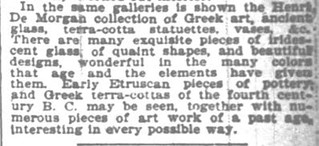 On March 11-12, 1895, De Morgan sold at auction antiquities and most probably ancient coins at Ortgies, New York. The New York Times, Sunday, March 3, 1895, page 17. Another more
elaborate article was also published in the New York Times, Thursday, March 7, 1895, page 4.
On March 11-12, 1895, De Morgan sold at auction antiquities and most probably ancient coins at Ortgies, New York. The New York Times, Sunday, March 3, 1895, page 17. Another more
elaborate article was also published in the New York Times, Thursday, March 7, 1895, page 4.
On February 10, 1898, De Morgan lectured on "Prehistoric Egypt" at the American Numismatic and Archaeological Society at the Academy of Medicine Building. The lecture largely debunked the mendacious article "Remarkable Discoveries by Archaeologists in the Valley of the Nile," New York Herald, July 4, 1898, illustrated with photos purportedly by Henri De Morgan. De Morgan showed how the article was contrived and the photographs fakes and not by him. A very lengthy piece reporting this in detail was published the following day in the New York Times, Friday, February 11, 1898 on page 7.
On October 17, 1909 he became incapacitated by cerebral hemorrhage and died nearly a month later at his home in le château d'Orliénas, Francescas, Lot-et-Garonne, Aquitaine, France, on November 13, 1909.
To read the complete article, see:
DE MORGAN, HENRI
(https://sites.google.com/a/numismaticmall.com/www/numismaticmall-com/de-morgan-henri)
QUICK QUIZ: MYSTERY YOUNG NUMISMATIST
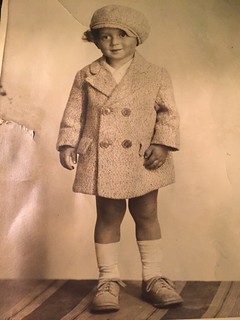
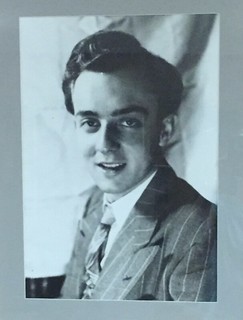
THE BOOK BAZARRE
ARTICLE FEATURES COLONIAL FISCAL PAPER

The taxes on colonial trade raised revenue that funded most of the routine costs of governmental administration in the American colonies and helped finance the loans that the British floated to fight its colonial wars. The taxes also served as a means for regulating economic activity according to mercantilist principles. The current consensus of historians is that this regulatory taxation proved only moderately burdensome to the colonial economy. Moreover, powerful commercial and agricultural elites in the colonies understood that the benefits of membership in the empire, especially naval power exerted on behalf of trade expansion, outweighed the costs of the mercantile system that penalized trade with other empires and nations.
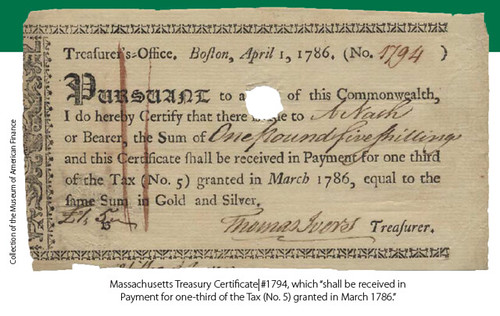
The fiscal transitions between the end of the Revolution and the early 1790s seemed prolonged and painful at the time, but the new nation actually created its modern fiscal state rather quickly. This was primarily because America’s financial leaders, especially Secretary of the Treasury Alexander Hamilton and Robert Morris, had acquired intimate familiarity with the British fiscal state. The most dramatic and influential steps came with the enactment of Hamilton’s financial program during the first administration of President George Washington. Hamilton and the other architects of the fiscal state made taxation its lynchpin. As in Britain, taxes would fund important national projects directly and also pay the interest required to support national debt. Also as in Britain, national taxation would draw most heavily on customs duties. Hamilton intended that the central government would keep the duties at relatively low levels by spreading the costs of the federal government, primarily the management of the federal debt, over a broad base of taxation.
The new American fiscal state was a worthy successor to the British fiscal state. Moderate tariffs, helped by generally strong economic growth and dynamic exports, paid off the national debt, including the money borrowed by President Thomas Jefferson to fund the Louisiana Purchase. In addition, the tariff revenues, supplemented at times by excises and special property taxes, funded the military expenses of the republic.
For more information on the Museum of American Finance, see:
https://www.moaf.org/

NICKLE GALLERIES: COINS OF JESUS EXHIBIT
Collection Specialist Marina Fischer of the University of Calgary writes:
The University of Calgary in Canada has a vast numismatic collection housed at its museum called Nickle Galleries. Annual coin exhibitions are organized and the current one is titled COINS OF JESUS: Money and Religion in the Ancient World. There are 130 coins on display, some very rare.
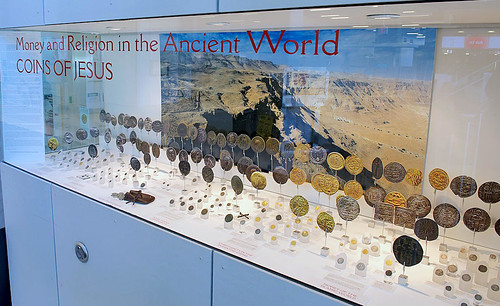
Coins of Jesus: Money and Religion in the Ancient World on display in Nickle Galleries until Sept 7
Organized by Nickle Galleries, Curated by Marina Fischer University of Calgary, Canada
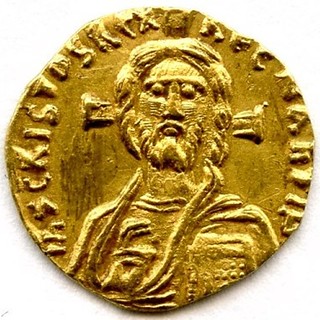 A stunning selection of Jewish, Christian and Islamic coins is now on display in the University of Calgary's Nickle Galleries in the exhibition Coins of Jesus: Money and Religion in
the Ancient World. The gallery houses one of the most significant numismatic collections in Canada.
A stunning selection of Jewish, Christian and Islamic coins is now on display in the University of Calgary's Nickle Galleries in the exhibition Coins of Jesus: Money and Religion in
the Ancient World. The gallery houses one of the most significant numismatic collections in Canada.
Through ancient money, this exhibition explores the world's religious history and its cultural and ideological diversity. It begins with Persian Imperial coins - the only coins referenced in the Old Testament of the Bible - and the renowned Phoenician shekels. Next, striking examples of Jewish, Judeo-Roman, Roman Christian and Byzantine gold, silver and bronze coinage - including coins of Pontius Pilate, Jewish Revolts and the first coin with Christ's image. Finally, wide-ranging Islamic and medieval money can be seen plus the very first Islamic coin without pictorial symbols - the radical redesign which occurred at the end of the seventh century.
The Nickle coin collection is a rich teaching and research resource, providing for the interest and enjoyment of the university and the community as a whole. We are sure the visitors will find the exhibition an intellectually and artistically rewarding journey.
The significant founding donation of 11,000 ancient coins was presented to the University of Calgary in 1980 by Carl O. Nickle. The collection has since been broadened through the generosity of The Nickle Family Foundation and others, such as the Conn, de Groot, Wright, Chessman and Manz families, and is now comprised of 23,000 pieces. View the collection here: http://emuseum.ucalgary.ca/ .
Coins of Jesus runs until Sept 7. The display is located in the Gallery Hall window on the main floor of the Taylor Family Digital Library.
A special exhibition will be organized for the University's Alumni Weekend on September 22-24, 2017 with two talks about the coins: http://www.ucalgary.ca/alumniweekend/sessions .
Admission and all events are FREE.
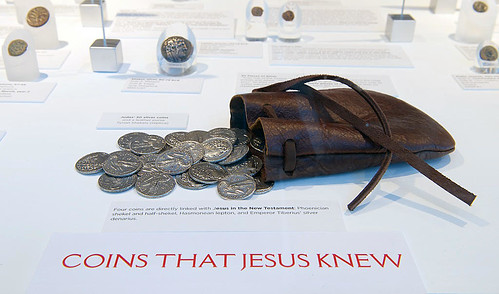
Nickle Galleries
University of Calgary
TFDL, 2500 University Dr. NW
Calgary, T2N 1N4 Canada
http://nickle.ucalgary.ca/
For more information, see:
Coins of Jesus: Money and Religion in the Ancient World
(http://nickle.ucalgary.ca/exhibitions/item/coins-jesus-money-and-religion-ancient-world)
KUNSTHISTORISCHES MUSEUM: MEDALS OF MARIA THERESA
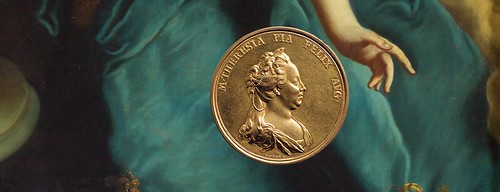
The Kunsthistorisches Museum’s Coin Collection holds both the largest and by far the most important collection of coins minted under Maria Theresa; it is the best place, and now is the best time, to host an exhibition that presents the monarch’s life in medals to celebrate what would have been her 300th birthday.
The exhibition focuses on the most important topoi in Maria Theresa’s private and public life. It presents her in the company of her large family, running the gamut of events from dynastic marriages to heart-breaking calamities. It showcases her role as a ruler forced to fight several wars for her inheritance and, together with her son and co-regent Joseph II, as a pioneering social reformer. The artefacts on show also illustrate the extent of Maria Theresa’s realm, which comprised many different ethnicities and cultures.
All these topoi are reflected in medals that emblematise historical events with the help of allegories. Maria Theresa was already widely glorified and celebrated during her lifetime, but the exhibition also documents how she was portrayed by her enemies. So-called satirical medals, which were passed around in private, turned Maria Theresa into an object of derision.
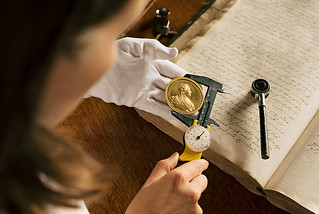 The exhibition focuses too on the historical background of medal production to illustrate the requisite technical skills, expenditure and effort, introduce the most important protagonists,
and document range, purview and media-value of Maria Theresa’s medals.
The exhibition focuses too on the historical background of medal production to illustrate the requisite technical skills, expenditure and effort, introduce the most important protagonists,
and document range, purview and media-value of Maria Theresa’s medals.
Miniature Memorials – Minted for Eternity Maria Theresa (1717-1780) became a legend during her lifetime, and few female rulers were depicted more frequently or diversely. Her many likenesses – among them portraits, engravings, medals and medallions – were designed to preserve her memory for posterity, turning her into an 18th century media-star.
Medals played a central role in this propaganda effort controlled by the imperial court. Among the period’s foremost artistic mass media, medals were minted under the aegis of the court, and they continue to reflect the ruler’s political aims and the way she saw herself. Over three hundred different medals were produced during Maria Theresa’s reign to commemorate or celebrate either members of the imperial family or political events, both national and international.
Medals functioned as a way to commemorate important events of her reign, and as they were minted in large numbers, the material is noted for its longevity and their handy format made it easy to disseminate them, they were regarded as a historical record that would last forever. Contemporaries called these miniature memorials show- or commemorative coins, and they evolved into much sought-after and frequently exchanged collectors’ pieces. The monarch presented them as signs of imperial favour, in recognition of the recipient’s merits or achievements, or to strengthen diplomatic ties, and the majority of the medals produced in Vienna were destined for the court – ending up in Her Majesty’s hands.
To read the complete article, see:
In Her Majesty's Hands: Medals of Maria Theresa on
view at the Kunsthistorisches Museum (http://artdaily.com/news/96875/In-Her-Majesty-s-Hands--Medals-of-Maria-Theresa-on-view-at-the-Kunsthistorisches-Museum#.WZQiKlGGOAs)
For more information, see: https://www.khm.at/en/visit/exhibitions/in-her-majestys-hands/
To read some earlier E-Sylum articles, see:
MARIA THERESIA THALER LITERATURE (http://www.coinbooks.org/esylum_v03n49a03.html)
BROOME BOOK ON MARIA THERESIA AVAILABLE (http://cbt.coinbooks.org/esylum_v03n53a05.html)
THE COINS OF MARIA THERESA (http://www.coinbooks.org/v20/esylum_v20n23a24.html)

MORE ABOUT ROYAL MINT ARTIST JODY CLARK
The Queen was deliberately 'de-blinged' for her latest coin portrait after she had her diamond-encrusted necklace removed, it has been revealed.
Jody Clark, 36, has revealed the secret omission from his design that appears on every British coin minted since 2015.
His original portrait was eventually approved by the Queen and Mint officials - but not before the Coronation necklace was removed from around her neck.
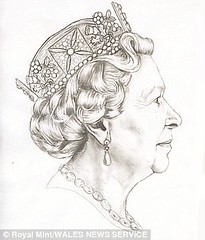
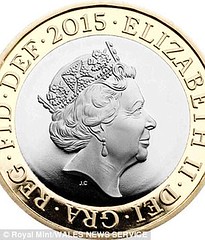
When the suggestion of a new portrait was suggested for 2015, Jody submitted his own drawing and was amazed when he was told his version had been chosen.
His original design included her crown, pearl drop earrings and Victorian necklace worn for official state functions. But he was told to axe the necklace from his final design. He revealed: 'I got to dress her up in what I thought would work best.
I researched what she wears and when she wears it and decided to go for the crown she generally wears to state openings and state visits, as I thought that was quite appropriate.
 The necklace first worn by Queen Victoria contains 26 giant diamonds set in silver, gold and platinum.
The necklace first worn by Queen Victoria contains 26 giant diamonds set in silver, gold and platinum.
Queen Elizabeth II received the coronation necklace when she came to the throne and can be seen in photos adorned with the 11.25 carat jewels on her neck.
The 26th diamond sits on a pedant suspended from the necklace and is 22.48 carats.
Jody, who is the youngest ever to design the effigy, won a competition just one year after starting work at the Royal Mint.
To read the complete article, see:
Royal Mint designer reveals he was told to 'de-bling' the Queen by removing her
diamond encrusted necklace from latest coin portrait (http://www.dailymail.co.uk/news/article-4792580/Royal-Mint-bling-Queen-latest-pound-design.html)
To read the earlier E-Sylum, see:
ARTICLE PROFILES JODY CLARK OF ROYAL MINT (http://www.coinbooks.org/v20/esylum_v20n33a15.html)
CLASSICAL NUMISMATIC GROUP SALE 106
CNG Auction 106 An Internet and Mail Bid Sale Closing Electronically on Wednesday, 13 September 2017, from 10 AM ET
Classical Numismatic Group is proud to present CNG 106, an Internet and Mail Bid Sale closing electronically on Wednesday, 13 September 2017, from 10 AM ET (U.S.). This sale offers 1151 lots with a presale estimate of $2.14 million.
Our annual autumn sale features Greek, Celtic, Oriental Greek, Central Asian, Roman Provincial, Roman Republican, and Roman Imperial coinage. Additionally, there are featured selections of Byzantine, Early Medieval, Islamic, World, World Medals, United States, British, and British Medals.
CNG 106 features Greek and Roman coins from the Bernert, West, and WN Collections, as well as diverse selections from the RAJ and Norman Frank Collections.
The Greek and Oriental Greek sections are highlighted by coins of Thrace and Macedon from the Belgica Collection, a Delphi tridrachm from the Ghazzat Hoard, a Kroisos prototype gold stater, selections of Oriental Greek and Central Asian coins from the Dr. Wilfried Pieper Collection, Persis and Sasanian coins from the Nisa Collection, and Kushan coins from the François Righetti collection.
The Roman Provincial section of CNG 106 also features coins from the François Righetti Collection, and a diverse selection of Roman gold coins, including a Caligula and Agrippina aureus, highlights the Roman coinage section.
The Byzantine section features another offering of coins from the Iconodule Collection, as well as an extremely rare Constantine VII and Zoe gold solidus. The World coins and medals section is highlighted by a contemporary boxed set of Napoleonic medals. The auction concludes with a diverse selection of British coinage and medals, including an extremely rare sceatt of Eardwulf, a Torksey penny of Cnut, and an exceptional emaciated groat of Henry V.
Catalogs for CNG 106 have been mailed to our active mailing list and bidding is open on the site. Some of the individual highlights from CNG 106 are:
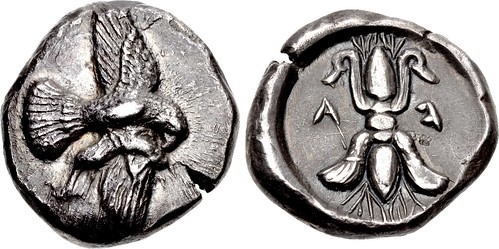
Lot 280–ELIS, Olympia. 83rd-85th Olympiad. 448-440 BC. AR Stater (22mm, 12.18 g, 10h). Eagle, wings spread, in flight right, holding dead hare in its talons and tearing at it / Vertical thunderbolt with volutes above and wings below; A (F retrograde) flanking; all within incuse circle. Seltman, Temple 59 var. (dies AK/– [unlisted rev. die]); BCD Olympia 31 var. (normal ethnic; same obv. die); HGC 5, 302 var. (same; same obv. die as illustration); SNG Delepierre 2056 (same rev. die); Gillet 967 (this coin). Good VF, old collection tone, minor edge split. Estimated at $10,000.
From the RAJ Collection. Ex CNG Inventory 724938 (February 2001); K. Davis FPL 33 (January 2001), no. 51; Charles Gillet Collection, 967.
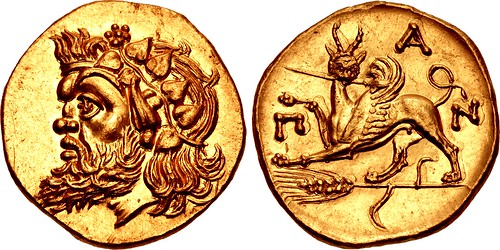
Lot 291–CIMMERIAN BOSPOROS, Pantikapaion. Circa 340-325 BC. AV Stater (21.5mm, 9.09 g, 11h). Head of Pan left, wearing ivy wreath / Griffin, holding spear in its mouth, standing left, head facing, forepaw raised, on grain ear; Π-A-N around. MacDonald 54; Anokhin 1021; HGC 7, 20; SNG BM Black Sea 864; Gulbenkian 587 = Locker-Lampson 123; cf. Kraay & Hirmer 440. EF, underlying luster, slight die shift, a few hairlines. Well centered on a broad flan. Estimated at $30,000.
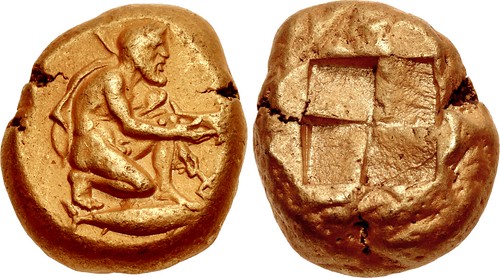
Lot 315–MYSIA, Kyzikos. Circa 450-330 BC. EL Stater (16.5mm, 16.02 g). Poseidon, nude but for cloak hanging over his left shoulder, kneeling right, holding dolphin in extended right hand, left hand holding trident downward, on tunny right / Quadripartite incuse square. Von Fritze I 146; Greenwell 6; cf. Boston MFA 1516 = Warren 1428 (hekte); SNG BN –; BMC 62; Gillet –; Gulbenkian –; Hunt II 462 = NAC 66, lot 50; Jameson –; Myrmekion 99; Rosen –; Weber –; CNG 105, lot 199; M&M AG 47, lot 489. VF, toned. Very rare, Greenwell noted only two examples (in the BM and a private collection), and CoinArchives includes only the Hunt and CNG 105 pieces. Traité notes an example in Paris, but this is erroneous, and the illustration listed for that example is actually the BM coin. Estimated at $5,000.
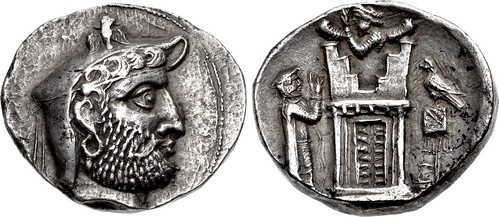
Partially Inscribed Tetradrachm of Vādfradād (Autophradates) II
Lot 544–KINGS of PERSIS. Vādfradād (Autophradates) II. Early-mid 2nd century BC. AR Tetradrachm (25.5mm, 16.66 g, 12h). Istakhr (Persepolis) mint. Bearded head right, wearing diadem and kyrbasia adorned with eagle / Fire temple of Ahura-Mazda; above, half-figure of Ahura-Mazda; to left, Vādfradād standing right, trace of bow before; to right, eagle standing left on standard; pt (= “f(ra)t(arakā)”) in Aramaic to right of altar. K&M 3/1 var. (no legend on rev.); cf. DeMorgan, p. 403 and pl. XXVIII, 8 (for obv.; same die); Sunrise 574 var. (same); cf. MACW 736 (drachm; wtprdt only); cf. CNG 97, lot 440 (tetradrachm with full Aramaic legend). Good VF, toned. Struck in high relief. Possibly unique variety of an extremely rare issue with reverse inscription. Estimated at $10,000.
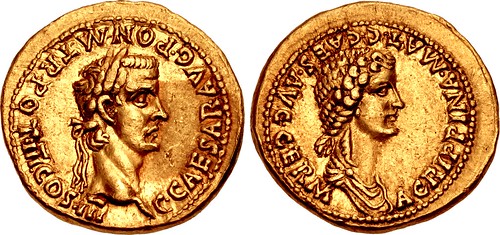
Lot 705–Gaius (Caligula), with Agrippina Senior. AD 37-41. AV Aureus (19.5mm, 7.77 g, 10h). Lugdunum (Lyon) mint. Struck AD 40. C • CAESAR • AVG • PON • M • TR • POT • III • COS • III, laureate head of Gaius (Caligula) right / AGRIPPINA • MAT • C • CAES • AVG • GERM, draped bust of Agrippina Senior right. RIC I 21; Lyon 178/2 (D182/R180); Calicó 327a (same obv. die as illustration); BMCRE 22; BN –; Biaggi 196; Mazzini 5 (same obv. die); Jameson 39. Good VF, toned, light marks. Well struck on a broad flan. Rare. Estimated at $50,000.
Caligula’s coinage types are largely dedicated to honoring his deceased ancestors, conveniently thereby advertising his own august lineage.
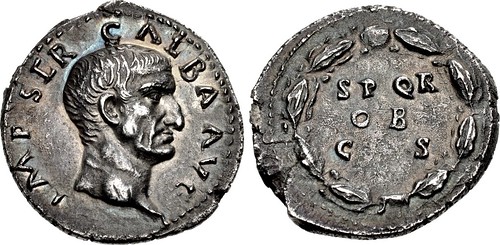
Lot 716–Galba. AD 68-69. AR Denarius (18mm, 3.18 g, 5h). Rome mint. Struck circa July AD 68 - January AD 69. IMP SER GΛLBA AVG, bare head right / S P Q R/ O • B/ C S in three lines within oak wreath. RIC I 167; RSC 287; BMCRE 34 corr. (head described as laureate); BN 76-7. EF, toned, some iridescence, minor porosity. Bold portrait. Estimated at $5,000.
From the WN Collection. Ex CNG Inventory 948328 (May 2013); Tkalec (28 February 2013), lot 141; Gemini VI (10 January 2010), lot 431.
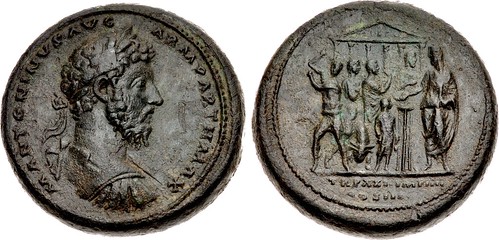
Lot 768–Marcus Aurelius. AD 161-180. Æ Medallion (41mm, 69.04 g, 12h). Rome mint. Struck AD 166–167. M ANTONINVS AVG ARM PARTH MAX, laureate and cuirassed bust right / Marcus standing left, wearing toga which is drawn up to cover his head, sacrificing over tripod; to left, victimarius about to strike bull and a child holding a simpulum; in background, hexastyle temple and three attendants, one playing double flute; TR P XXI IMP IIII/ COS III in exergue. Gnecchi 51, pl. 63, 2 (same dies); MIR 18, 1034-1/35; Banti 472. Good VF, green patina, light natural roughness, faint old scratch before portrait. Extremely rare, three recorded by Gnecchi. Estimated at $20,000.
This solemn and well-balanced scene alludes to the ceremonies in observance of the vota publica.
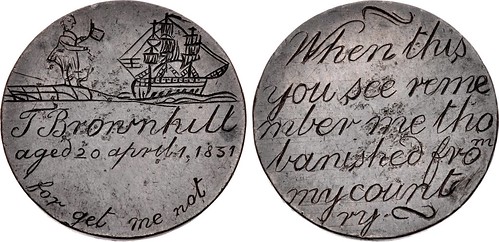
Lot 946–AUSTRALIA, Private Token Issues. Thomas Brownhill, convict, transported 1831-1832. Æ Convict Love Token (35.5mm, 23.25 g). Man standing right on shore, doffing hat, holding irons attached to his legs; to right, ship under sail right; below, T Brownhill/ aged 20 april 1, 1831/ for get me not / ~/ When this/ you see reme/mber me tho/ banished from/ my count/ry ~, all engraved on a smoothed Cartwheel-type penny. Michele Field & Timothy Millett, Convict Love Tokens (Kent Town, South Australia, 1998), p. 110 (for another token of Brownhill). Good VF. Recently discovered in a house clearance in the UK. Estimated at $2,000.
Thomas Brownhill was tried and convicted at the Warwick Assizes on 26 March 1831 for housebreaking, and sentenced to transportation. He sailed from Portsmouth on the Isabella on 27 November 1831, bound for Sydney. The voyage was marked by a mutiny of the ships crew, with fourteen being executed upon their arrival in Australia. But the convicts, Brownhill included, remained well-behaved, and are even reported to have helped the captain. Following their arrival in Australia, Brownhill was assigned to one W.T. Morris of Batemans Bay, where he died on 13 December 1840.
Brownhill is surprisingly known from another token in the Peter Lane Collection, bearing the initials and ages of his family members. Other records describe him as as literate, a Birmingham-born Protestant, and a ‘fancy plater’ by trade, with a tattoo on his lower right arm of a man and a woman and his initials.

Lot 1023–PERU, Colonial. Felipe V. King of Spain, first reign, 1700-1724. AV 8 Escudos (29.5mm, 27.06 g, 10h). Lima mint. Dated (1)712 L M. Coat-of-arms / Crowned Pillars of Hercules set on ocean waves. Calicó 438; KM 38.2; Friedberg 7. EF. Estimated at $5,000.
From the Norman Frank Collection. Ex Baldwin’s 24 (9 October 2000), lot 401; Kip Wagner Collection (sold privately to F.S. Werner and Spink); 1715 ‘Plate Fleet’.
The 1715 Treasure Fleet was a Spanish fleet returning with some of the wealth from its colonies in the Americas to Spain. A hurricane sank most of the ships in the fleet (eleven of the twelve ships) in the early morning of 31 July 1715 near present-day Vero Beach, Florida. Because the fleet was carrying silver, it is also known as the 1715 Plate Fleet, since plata in Spanish means silver. The wrecks were salvaged by the Real Eight Company, founded by Kip Wagner, from whose collection this piece originates.

Lot 1128–TUDOR. Elizabeth I. 1558-1603. AR Eight Testerns (41mm, 26.85 g, 1h). ‘Portcullis’ money. Tower (London) mint; im: O. Struck for the Company of Merchants of London Trading into the East Indies (East India Company), early 1600/1. O : ELIZABETH · D’ · G’ · ANG’ · FR’ · ET · HIB’ · REGINA ·, crowned coat-of-arms; crowned E R across field / O : POSVI · DEVM · ADIVTOREM · MEVM ·, crowned portcullis. BCW 0-1C/0-a; North –; SCBC 2607A. VF, toned. Rare. Estimated at $10,000.
From the RAJ Collection, purchased from Stephen Harvey, 2000. Ex Marian A. Sinton Collection (Triton III, 30 November 1999), lot 1519.
Printed catalogs for CNG 106 are now available. To order the catalog, please call our U.S. office at (717) 390-9194. Catalogs have been mailed to customers on CNG’s active mailing list. Prospective bidders may also view the virtual catalogs at CNG 106 Virtual Catalog. The sale can be viewed online at cngcoins.com, sixbid.com, and numisbids.com.
In addition to Internet & Mail Bid Sale 106, CNG will also feature over 1000 lots from many of the same collections listed above in their Electronic Auction 406, closing two weeks later on Wednesday, 27 September 2017, from 10AM ET (U.S.). Bidding for CNG Electronic Auction 406 will begin on 6 September 2017.
CNG is currently accepting consignments for future auctions sales. Please contact the firm for further details and consignment deadlines.
For further details and any additional information, please contact CNG, Inc. at:
Classical Numismatic Group, Inc.
P.O. Box 479
Lancaster, PA 17608-0479
Telephone: (717) 390-9194
Fax: (717) 390-9978
Email: cng@cngcoins.com

WAYNE'S NUMISMATIC DIARY: AUGUST 20, 2017
2017 Denver ANA Badge and Ribbons
 I didn't manage to finish my diary last week, so here goes. First, a few items to finish out my Denver ANA diary. Here's my badge and ribbons. I was stunned when I received my
notice that I was a 25-year member. I'd joined back when I'd gotten out of college and had no idea so much time had passed. It's a Participation Trophy for not having quit or died yet,
but I wear it proudly.
I didn't manage to finish my diary last week, so here goes. First, a few items to finish out my Denver ANA diary. Here's my badge and ribbons. I was stunned when I received my
notice that I was a 25-year member. I'd joined back when I'd gotten out of college and had no idea so much time had passed. It's a Participation Trophy for not having quit or died yet,
but I wear it proudly.
I'm even prouder of the other two -the Goodfellow award is for being a convention chairman, a job I held for the 2004 Pittsburgh show. Having met Glenn Smedley back around 1980 in a visit to
ANA headquarters in Colorado Springs, I was was quite happy to receive that a number of years later.
![]()
Levick Plates
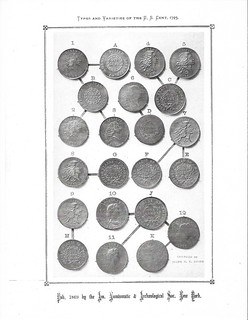
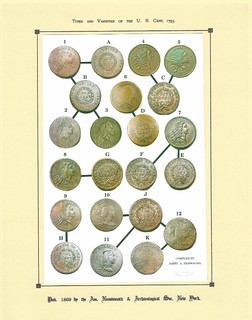
While walking from the meeting rooms back to the bourse one day I ran into Jim Neiswnter and Jan Valentine of Colorado Springs. Jim had a present for me - a color recreation of the famous plate of 1793 Large Cents by J.N.T.Levick in the April 1869 issue of the American Journal of Numismatics.
To read the earlier E-Sylum article, see:
ARTICLE EXPLORES THE 1869 AJN LEVICK PLATE OF 1793 CENTS (http://www.coinbooks.org/esylum_v11n34a07.html)
Denver Show Ephemera
Here are a couple items I picked up while at the show. The first is a handout from Don Kagin's table about the Nova Constellatio Quint pattern on display there. The second item is from the
Heritage table, describing Continental Dollars from the Resolute collection (displayed over at the NGC booth).
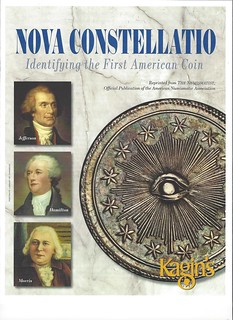
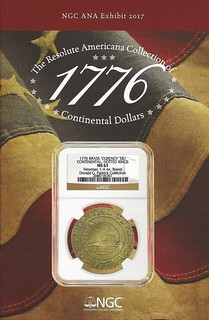
August 2017 Nummis Nova
The Tuesday following the ANA convention (August 8, 2017) was the regular meeting of my Northern Virginia Numismatic Social group, Nummis Nova. We were actually meeting in Bowie Maryland at
Jerry's Seafood, a favorite restaurant of our host Julian Leidman.
I arrived earlier than planned and was actually the first of our group to show up. I didn't have to wait long before Ron Abler, Dave Schenkman and Gene Brandenburg arrived and soon we were ordering beers in the bar. Not long after that we were seated at our table. Soon came Eric Schena, our host Julian, Steve Bishop, and my guest E-Sylum reader and contributor Chip Howell. It was a smaller group than usual due to summer vacations and the location.
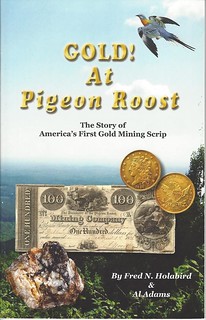 Dave Schenkman brought a present for me - a copy of the 2010 booklet by Fred Holabird and Al Adams about the scrip issued by the Pigeon Roost Mining Company of Georgia. It's a
well-researched and illustrated book that fleshes out an interesting aspect of the story of America's first gold rush. The complete title is GOLD! At Pigeon Roost - The Story of America's
First Gold Mining Scrip. Thanks, Dave!
Dave Schenkman brought a present for me - a copy of the 2010 booklet by Fred Holabird and Al Adams about the scrip issued by the Pigeon Roost Mining Company of Georgia. It's a
well-researched and illustrated book that fleshes out an interesting aspect of the story of America's first gold rush. The complete title is GOLD! At Pigeon Roost - The Story of America's
First Gold Mining Scrip. Thanks, Dave!
I'd brought for display the PCGS Education Award plaques for The E-Sylum along with the ephemera (pictured above) and books that I'd picked up at the ANA convention. I resold at cost to Eric Schena the copy of the 1991 American Numismatic Association Centennial anthology I'd purchased at the Numismatic Bibliomania Society fundraising auction.
Below is my other purchase from the NBS sale, a copy of the published Douglas manuscript of New Jersey Coppers (a keeper) and a piece of ANA ephemera not yet pictured, a brochure for the book 1792 Birth of a Nation's Coinage.

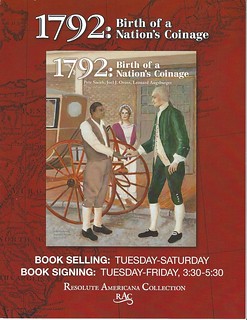
Here are some photos.
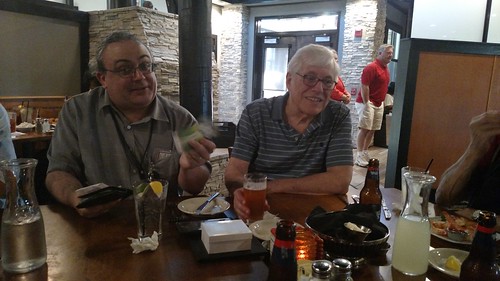
Eric Schena and Dave Schenkman
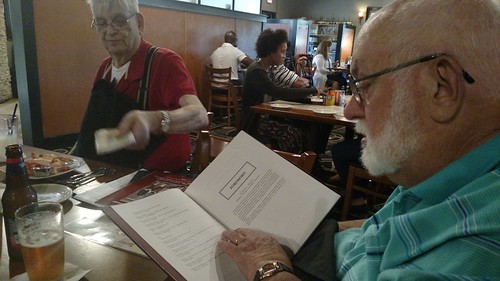
Julian Leidman and Dave Brandenburg (perusing one of my books)
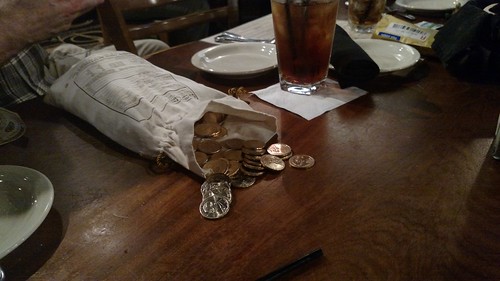
Chip Howell's bag of Presidential dollars
Several of us enjoyed the restaurant's specialty, the Crab Bomb. I had the spicy version called the Firecracker. It was an excellent meal and it was no surprise that the place was quite full on a Tuesday night.
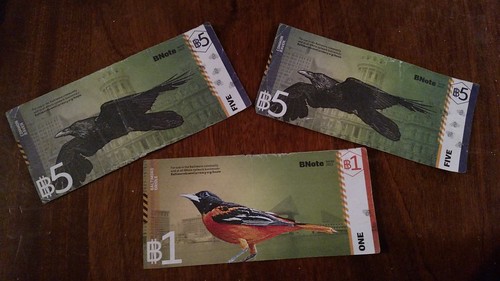
Baltimore B-Notes
Chip brought for me some circulated Baltimore B-Notes, a local alternative currency.
To read the earlier E-Sylum articles, see:
WASHINGTON POST ARTICLE ON LOCAL CURRENCY (http://www.coinbooks.org/esylum_v15n48a16.html)
BALTIMORE BNOTE SECOND SERIES ISSUED (http://cbt.coinbooks.org/esylum_v19n19a31.html)
Steve's Beauties
We can always seem to count on Steve Bishop to bring some nice coins. He provided these images. Thanks!
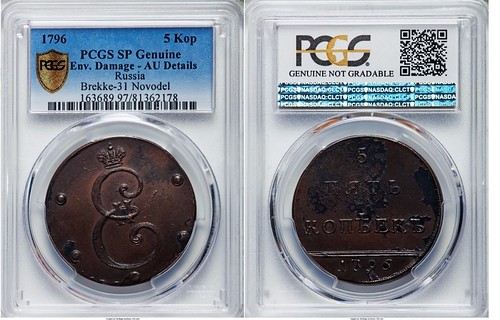
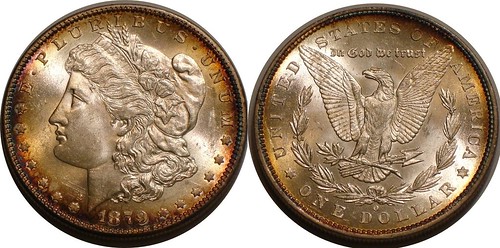
Vermeil Medals
Ron, Chip and I were the last to leave and had a good conversation on a number of topics, including Wikipedia and Ron's book on Centennial Medals. A story about his purchase of a medal that
turned out to be a true rarity led to a discussion of an informal hiererachy of award medal classification that is seen a lot in 19th century award competitions:
1. gold
2. gold-plated silver
3. silver
4. silver-plated bronze or copper
5. bronze
We learned a new term from Ron Abler. He writes:
Gold-plated silver is vermeil (pronounced ver-may or vermul).
Chip later provided some Wikipedia definitions.
Silver-gilt or gilded/gilt silver, sometimes known in American English by the French term vermeil, is silver (either pure or sterling) which has been gilded with gold. Most large objects made in goldsmithing that appear to be gold are actually silver-gilt; for example most sporting trophies (including medals such as the gold medals awarded in all Olympic Games after 1912) and many crown jewels are silver-gilt objects.
Apart from the raw materials being much less expensive to acquire than solid gold of any karat, large silver-gilt objects are also noticeably lighter if lifted, as well as more durable (gold is about as heavy as lead and is highly malleable/ easily scratched). Compared to objects made of ungilded sterling silver which have intricate detail like monstrances, gilding, which limits oxidation of the underlying metals, greatly reduces the need for cleaning and polishing, and so reduces the risk of damage to them.
At my request, Dick Johnson's Vocabulary article for this week covers the term. See the article elsewhere in this issue for more information.
To read the complete articles, see:
Silver-gilt (https://en.wikipedia.org/wiki/Silver-gilt#Vermeil)
vermeil (https://en.wiktionary.org/wiki/vermeil#Noun)
Where's George

Later in the week I got around to recording and respending a dollar bill I'd come across with a "Where's George" stamp. The www.wheresgeorge.com web site allows users to track the local of bills as recorded by people what have come into contact with them in the course of daily commerce.
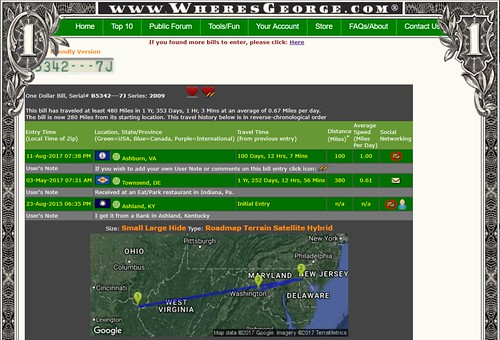
To read the earlier E-Sylum articles, see:
WHERE'S GEORGE (http://www.coinbooks.org/esylum_v06n02a17.html)
WHERE'S GEORGE (http://www.coinbooks.org/esylum_v07n07a14.html)
That's all for this time.
THE ‘NEAR SPILSBY ROMAN COIN HOARD
 A long-forgotten hidden hoard of Roman coins unearthed on farmland in Lincolnshire is coming up for auction.
A long-forgotten hidden hoard of Roman coins unearthed on farmland in Lincolnshire is coming up for auction.
The complete ‘Near Spilsby’ collection of 281 Roman coins was discovered by two metal detectorists.
The mainly bronze coins, featuring Roman emperor Constantine the Great and members of his family, would have been buried in the ground near Spilsby around 340 AD but were never recovered by the original owner.
The Midlands metal detectorists who found the coins wish to remain anonymous, but one of them said: “The coins would have been hidden there by someone who planned to return but they never did. Who knows what happened to them.
“The coins lay hidden in the ground for almost 1,700 years – until we came along. We were passing by one day, spotted the farmer in the field and asked if we could go on to his land with our metal detectors. He said yes, and we split up in different directions.
“My friend suddenly shouted that she had found one coin, then two, then three. She said, ‘I think it’s a hoard’. By the time I reached her she had 20.
“It is not that unusual to find the odd Roman coin but to find an entire secret hoard is very rare. We called in the farmer to help and that day, in 2014, we found 100 coins.
“After the farmer has cleared his crop the following year, we were given permission to go back and found another 181 Roman coins.
The Roman mints at Arles, Lyon and Trier produced the majority of the coins but they also include examples struck at the ancient Roman cities of Siscia and Aquileia as well as Rome.
As well as Constantine I, the coins depict Constantine II, Contans, Constantius, Helena, Theodora and Delmatius.
To read the complete article, see:
Stunned metal detectorists discover hoard of 1,700-year-old coins buried in a farmer's
field (http://www.lincolnshirelive.co.uk/news/local-news/stunned-metal-detectors-discover-hoard-338853)
DETECTORIST FINDS RARE 6TH CENTURY COIN PENDANT
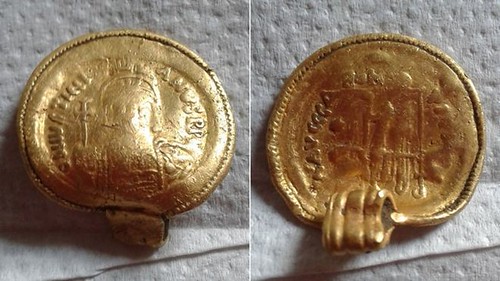
A rare 6th Century gold pendant created from a Byzantine coin has been found by a metal detectorist more than 1,500 years after it was made.
The coin is imprinted with an image of Emperor Justinian and is thought to have been made in Constantinople, which is now known as Istanbul in Turkey.
It was found by Godfrey Pratt in a field near Attleborough, Norfolk.
The metal detectorist said he had made some finds which were of archaeological interest but this one was "bling".
Mr Pratt, who lives near the town, said: "I was amazed how perfect it came out of the ground... gold and sparkly."
Dr Marsden said: "What we're looking at is a coin which was probably produced in the 530s or 540s AD.
"Later in its life it came over from the Mediterranean to Britain, was turned into a piece of jewellery and gone into the ground in a burial, probably as a very much-loved pendant." He said it could indicate there was a cemetery on the field where it was found.
"There could be more stuff out there, time will tell," said Dr Marsden.
A similar-looking coin was found in North Elmham in Norfolk in 2013. That one was a French imitation of a Byzantine coin. However, this latest find was the "real thing", said Dr Marsden.
To read the complete article, see:
Metal detectorist finds rare 6th Century coin pendant (http://www.bbc.com/news/uk-england-norfolk-40962865)
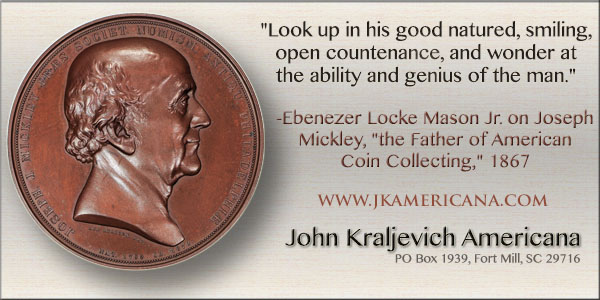
DUTCH SHIP ROOSWIJK EXCAVATED
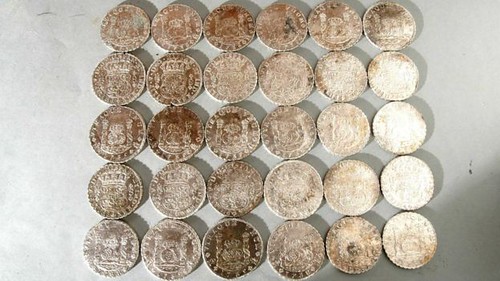
A ship excavation is expected to reveal a "treasure trove" of items and stories from Europe's global trading history.
An international team of maritime archaeologists are diving, excavating and recording the wreck of Dutch ship the Rooswijk off the Kent coast.
All 300 shipmen died when the vessel, carrying coins and silver ingots, sank on Goodwin Sands in January 1740.
Never before have any of the Dutch East India Company's 250 wrecks been scientifically excavated on this scale.
Historic England manages the protected site and is working with the Dutch government, which owns the ship's remains.
It is only now, after more than 250 years, that the sands have shifted enough to unveil the wreckage.
Some explorations were carried out last year and those finds are being showcased as part of the #Rooswijk1740 project, led and financed by the Cultural Heritage Agency of the Netherlands, with open days in Ramsgate between 19 August and 16 September.
Alison James, maritime archaeologist at Historic England, said: "Wrecks such as the Rooswijk are time capsules that offer a unique glimpse into the past and tell a story.
"We look forward to the fascinating insights and discoveries that the Rooswijk excavation will uncover this summer."
To read the complete article, see:
Goodwin Sands 'treasure trove' Dutch shipwreck excavated (http://www.bbc.com/news/uk-england-kent-40962097)
THE FOUNDING OF THE CENTRAL AMERICAN MINT
Roberto Jovel of Santiago, Chile writes:
The 125th anniversary of the founding of the (now-extinct) Central American Mint, Ltd., which was the first official mint of El Salvador, will be on August 28, 2017. A colleague of mine, Ivan Zelaya, is writing a book on the history of the CAM that includes full particulars of the enterprise and its production, much of which is still unknown to the average numismatist, and which will be published at the end of this year.
125th Anniversary of its founding in San Salvador, El Salvador
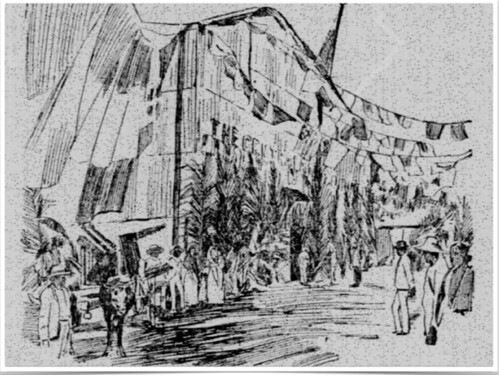
The Central American Mint
The 125th anniversary of the founding of the El Salvador Mint, whose original title was "The Central American Mint, Ltd.", will be on August 28, 2017. The Mint closed operations in January 1896 due to political difficulties with the government that had earlier deposed – through a military coup – the Administration of former Salvadorian President Carlos Ezeta who had founded the Mint in 1892.
The new government felt that the cost of striking coins was excessive and that it would be more economically advantageous to have foreign mints produce the coins required by the country, after the international price of Silver had declined significantly in comparison to that of Gold.
For more than 70 years, after Independence from Spain, El Salvador had strived to have its own minting facility to strike the circulating media it required to facilitate daily trade in its local markets. A first provisional set of coins had been minted in San Salvador during 1828, when the capital city was under siege by the Central American Federation army. General Francisco Morazán – President of Honduras at the time and a political ally of El Salvador`s Liberal government – came to the rescue of the Salvadorians and together they defeated the invading army. This fact partially explains why Morazán’s portrait is included in many Salvadorian coins of the twentieth Century. In the mid-1860s, Salvadorian President Gerardo Barrios made arrangements to strike coins bearing El Salvador´s coat of arms; his efforts yielded some beautiful patterns which never circulated in the country and which are very much in demand of Salvadorian and foreign numismatists.
It was only in 1891 when a concession was granted to a private entrepreneur – Dr. Enrique Arbizú – to set up a minting facility in San Salvador. Coins were to be struck on the basis of the 1883 Monetary Law, with minor adjustments to conform to the specifications of the Latin Monetary Union.
Nearly 2000 persons and government officials attended the inauguration ceremony of the Central American Mint (called “CAM” for short) on 28 August 1892, after Dr. Arbizú had concluded an agreement with an English firm, which brought the required machinery and expertise to El Salvador. During the inaugural ceremony, the Mint began production of the coins called “Bambas” by our grandparents, which presently fill our numismatic collections.

Medal Commemorating the founding of the Central American Mint, Ltd.
Between 1892 and 1896 the Central American Mint struck several million Pesos worth of Silver coins of different denominations, as well as a limited number of Gold coins. Those dated 1896 are extremely scarce and demand very high prices, especially in the better conditions. After the Mint closed operations, and from 1904 through 1914, Silver coins were minted in European and United States mints using the same matrixes developed by the CAM.

Image showing the public attending the CAM’s inaugural ceremony
The CAM struck coins to finance the local and international markets of El Salvador using locally produced metals as well as re-striking foreign Silver coins – from many countries, especially Peru and Chile – and older Silver cobs of different origin, and indirectly assisted in eliminating counterfeit coins from circulation.

A fully illustrated book on the detailed history of the Central American Mint is under preparation by Mr. Ivan Zelaya in San Salvador, that describes all particulars on the operation and production of the facility, should be available by year-end. Comments or queries on the subject may be sent to contacto@thecentralamericanmint.com
MODERN BANKNOTES OF THE NETHERLANDS ANTILLES
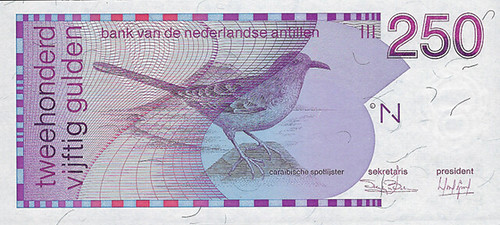
The various islands that made up the Netherlands Antilles prior to 1986 (Aruba, Sint Maarten, Saba, Sint Eustatius, Bonaire, and Curacao) were initially part of the Dutch colony of Curacao and Dependencies. After 1954, the islands received semi-autonomous status as a country within the Kingdom of the Netherlands. Banknotes were first issued for the colony around 1828, and the Curacaosche Bank would be the sole issuer of paper money throughout most of its history, with the last issue being dated 1960, already after the Netherlands Antilles had been formed. In 1962, the Bank of the Netherlands Antilles, a successor of the Curacaosche Bank, issued its first banknotes. Even though the bank was officially dissolved in 2010 and succeeded by the Central Bank of Curacao and Sint Maarten, banknotes in its name are still being issued. It’s a little bit of a confusing situation thanks to the complicated political history of the various islands, but the fact is that the current (and probably final) series issued by the Bank of the Netherlands Antilles is a fascinating series to collect, filled with very scarce and underrated dates.
Initially introduced as six denominations (5 gulden, 10 gulden, 25 gulden, 50 gulden, 100 gulden, and 250 gulden), the series was designed by Oscar Ravelo. The original series was dated March 31, 1986, but were not shipped to the Antilles until late 1987, and they first entered circulation in January of 1988. Higher denominations were also planned, but to this date have not come to fruition; in fact, the 250-gulden note was issued only in 1986 and even then saw very limited use. The 5-gulden note was also discontinued after 1994 when it was replaced by a coin of the same value.
To read the complete article, see:
The modern bird banknote series of the Netherlands Antilles, 1986 to present
(http://news.coinupdate.com/the-modern-bird-banknote-series-of-the-netherlands-antilles-1986-to-present/)

